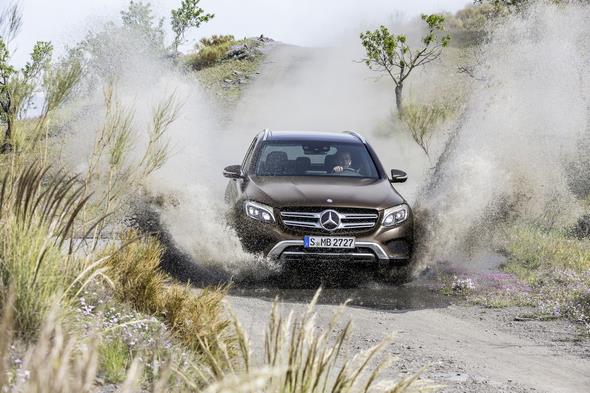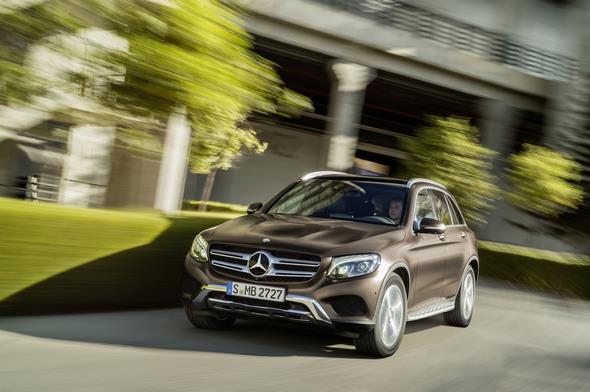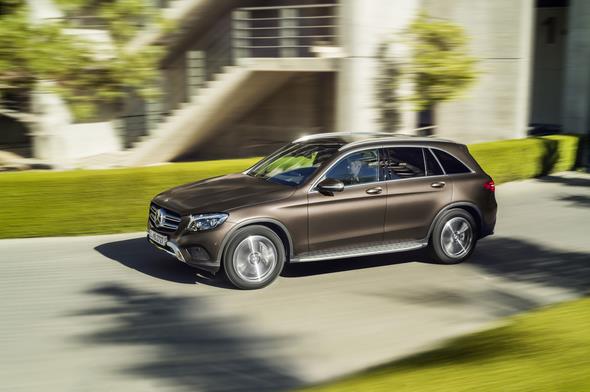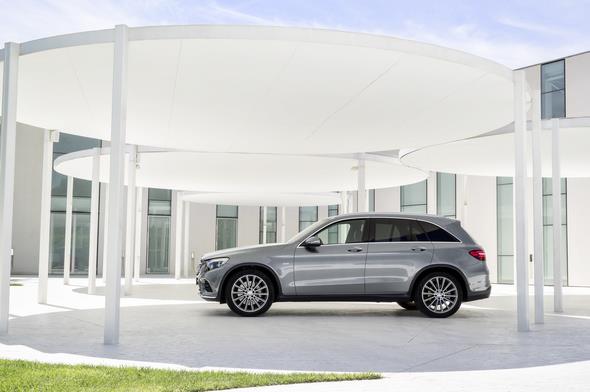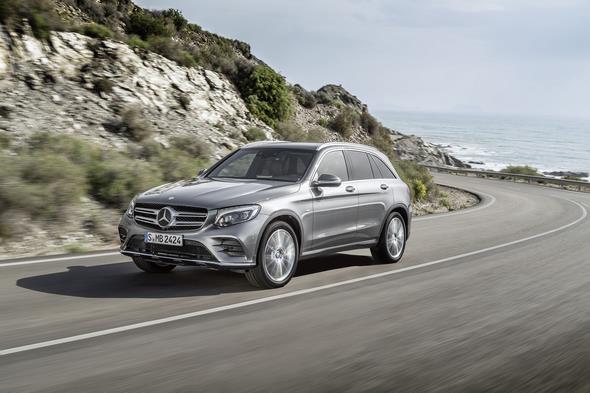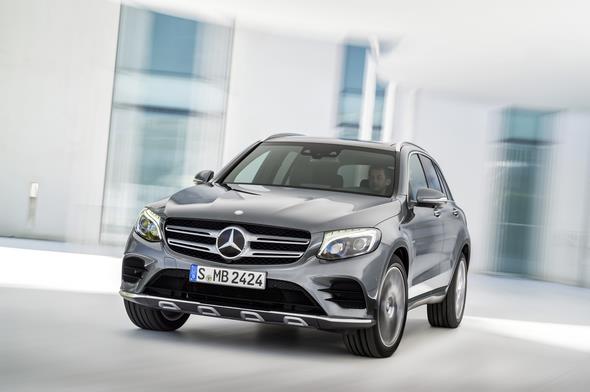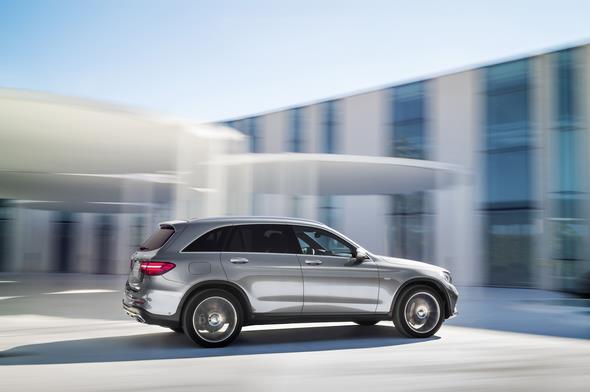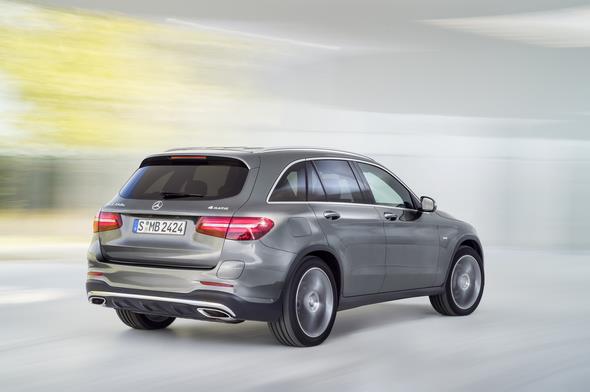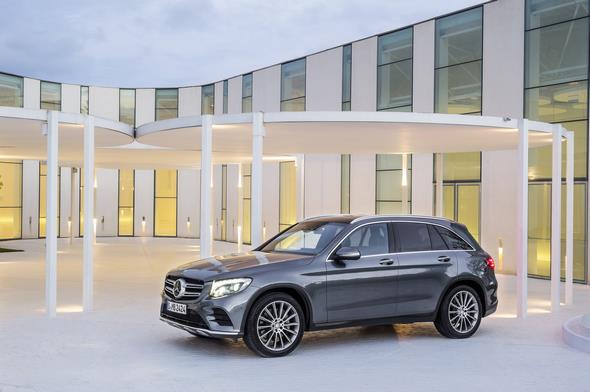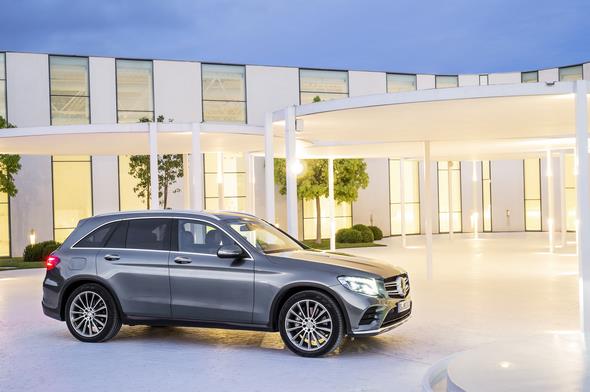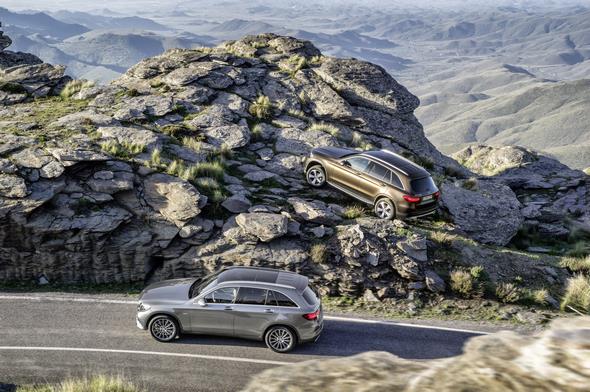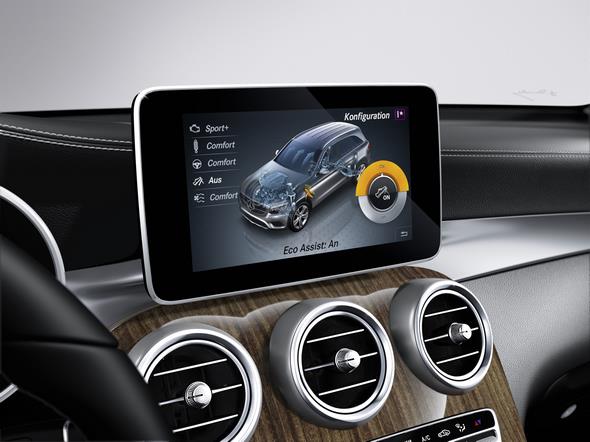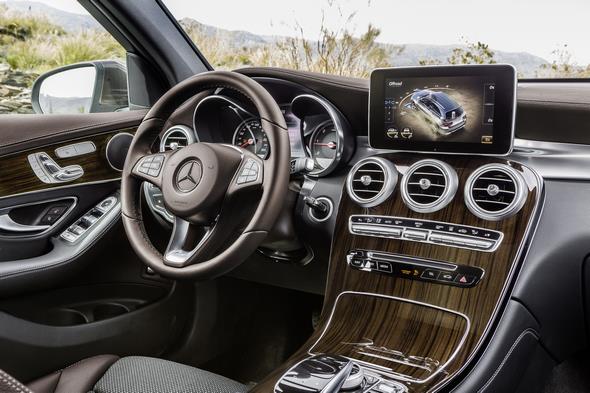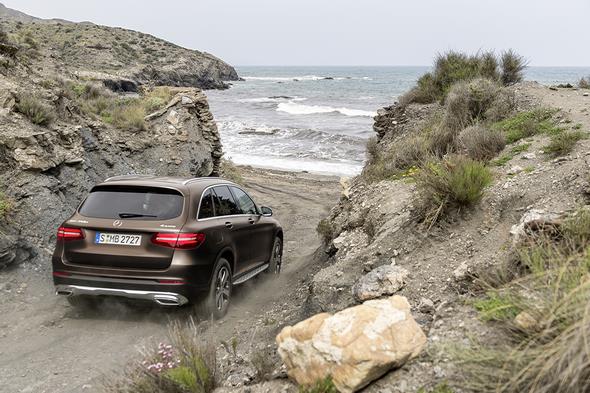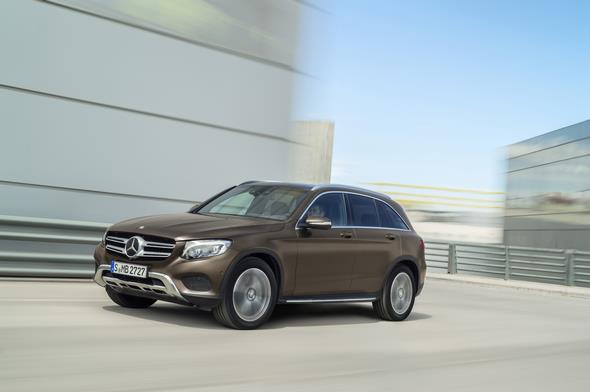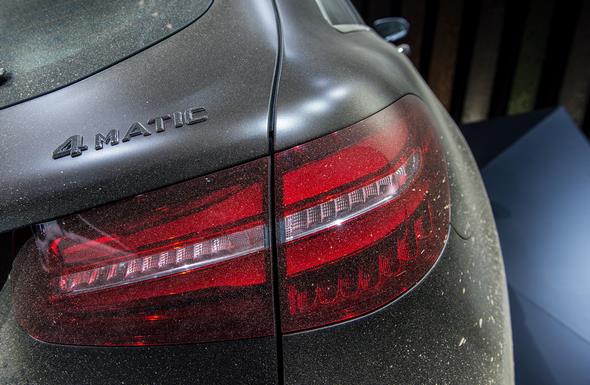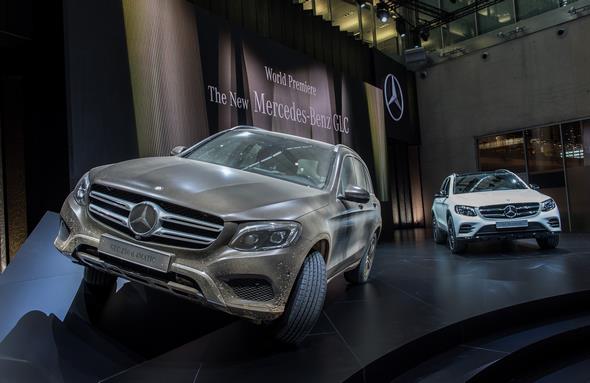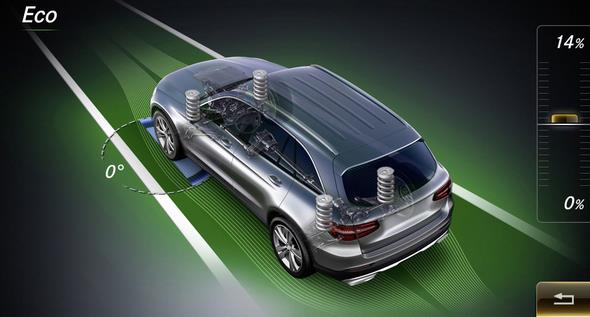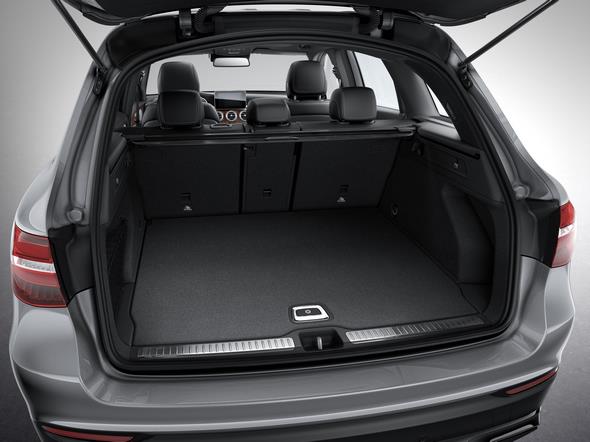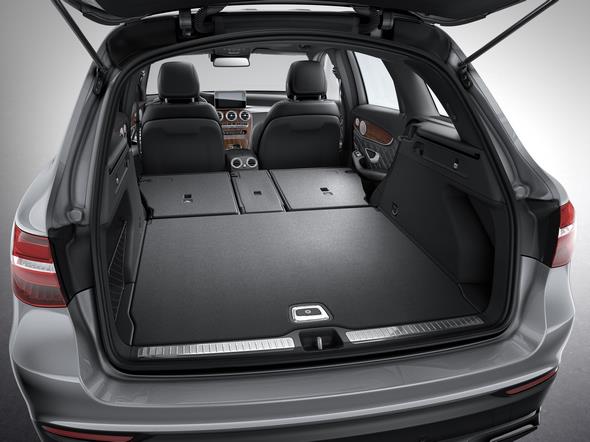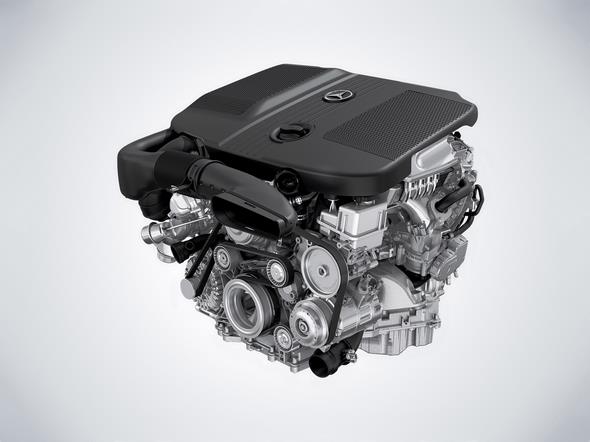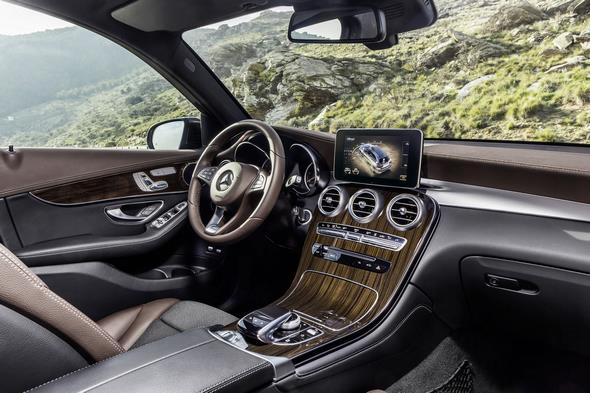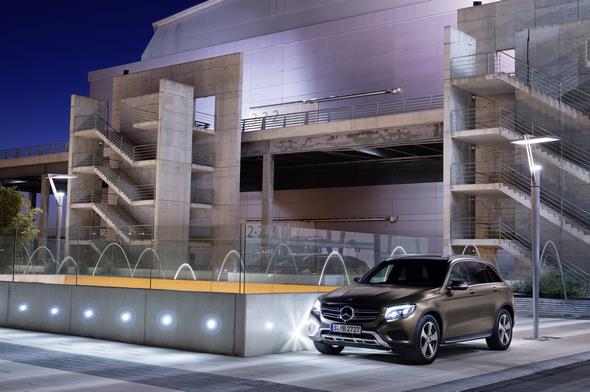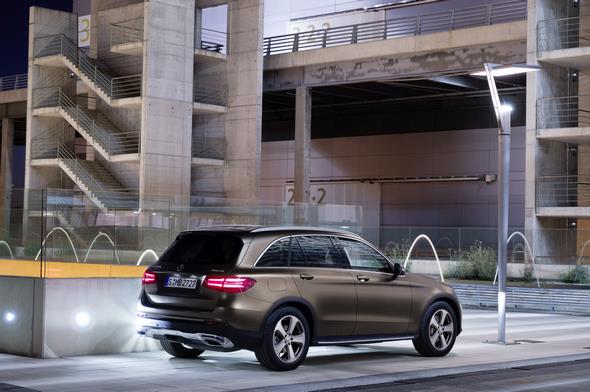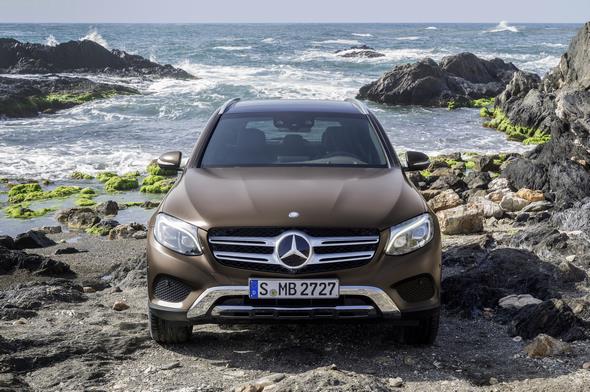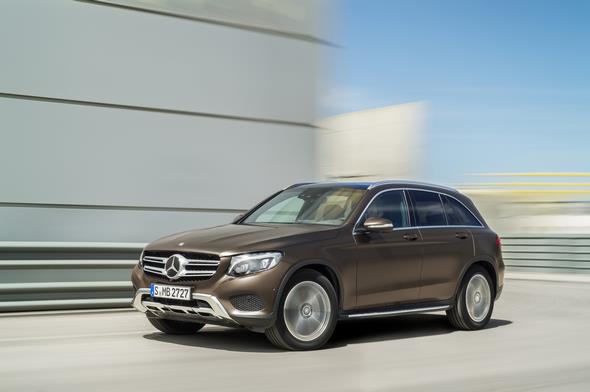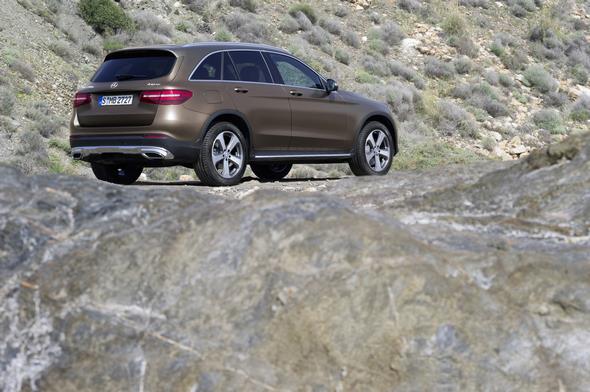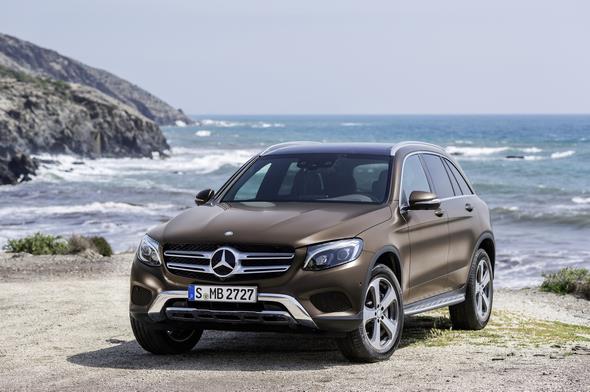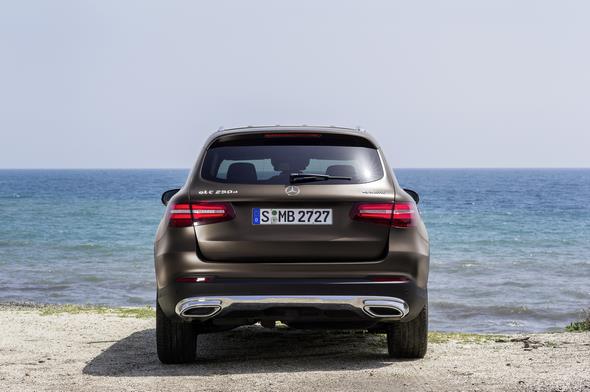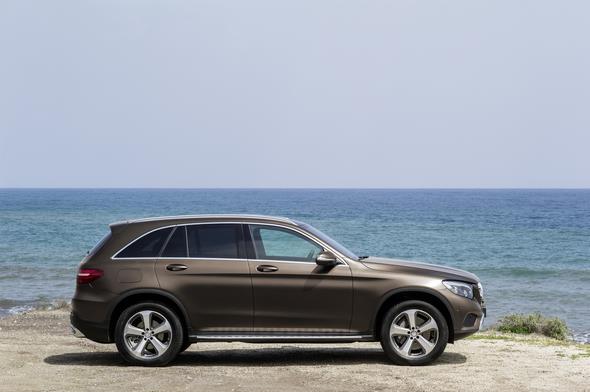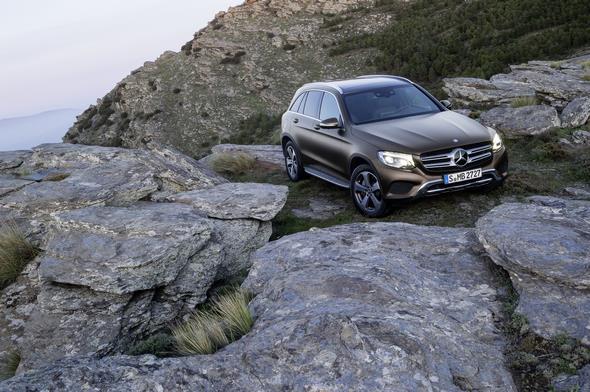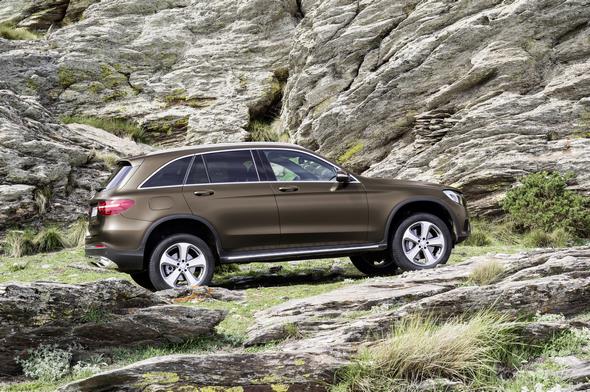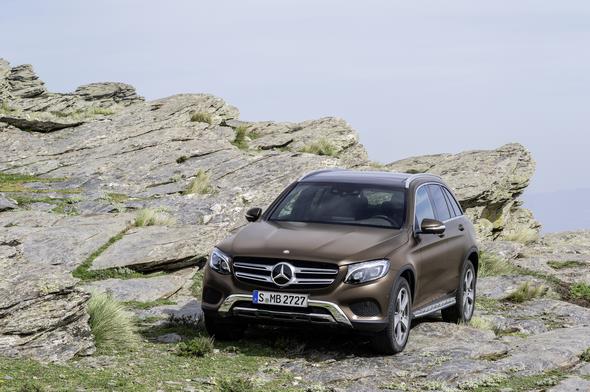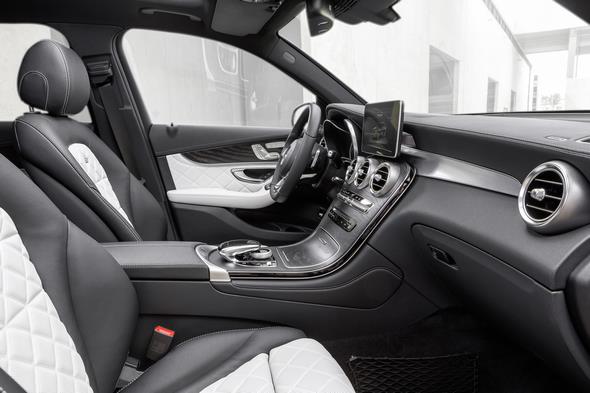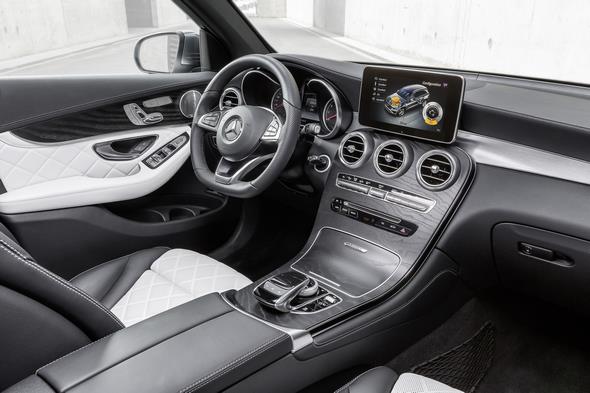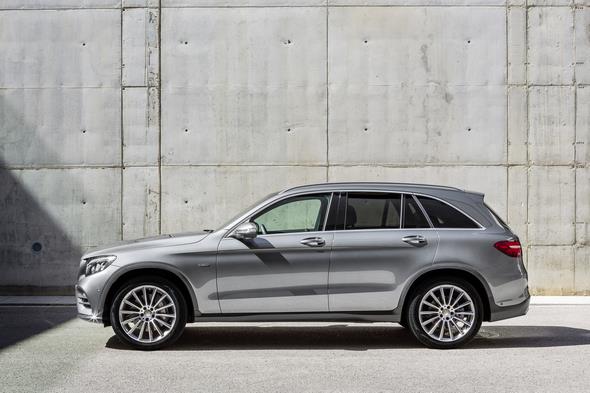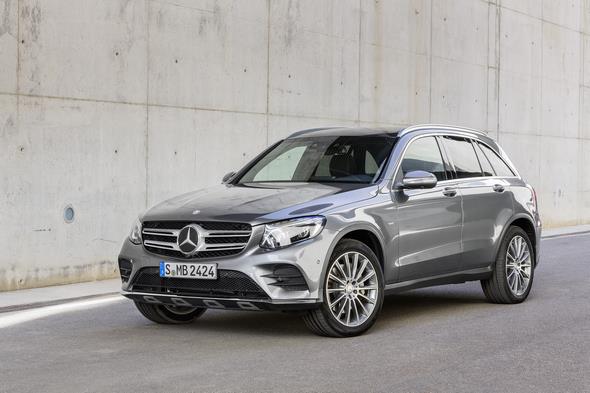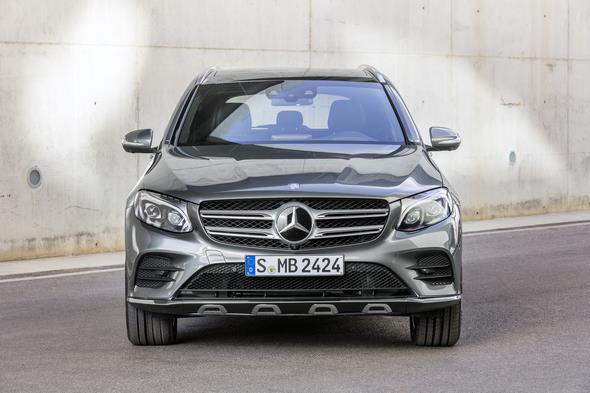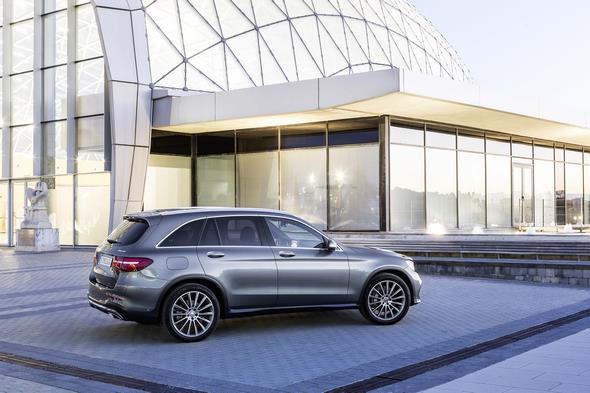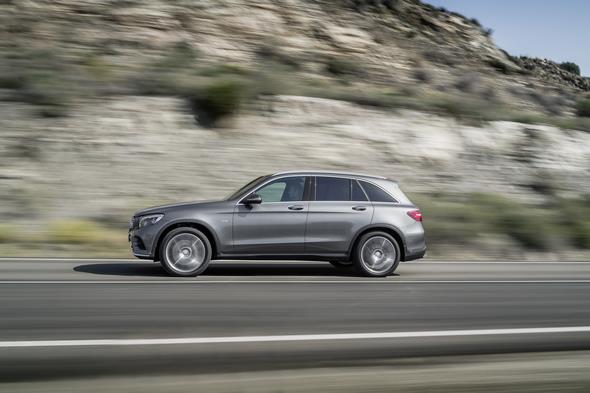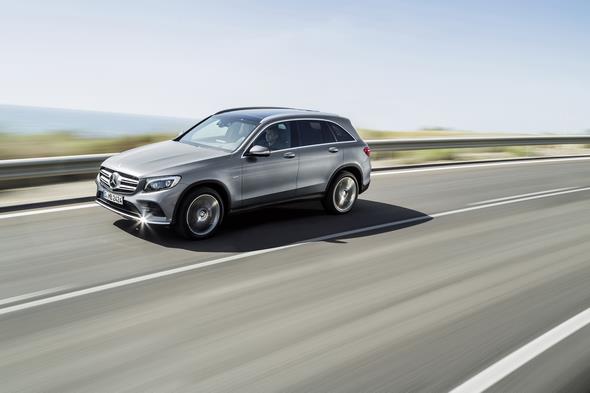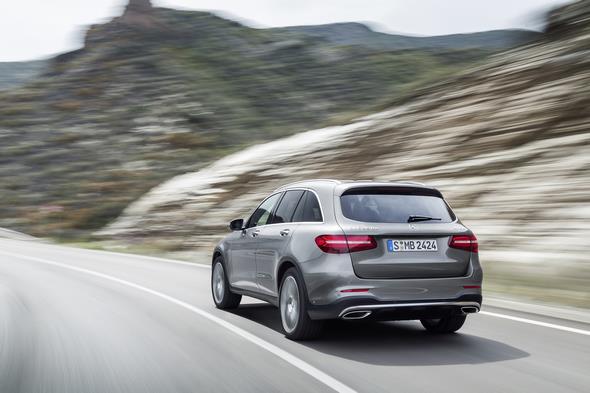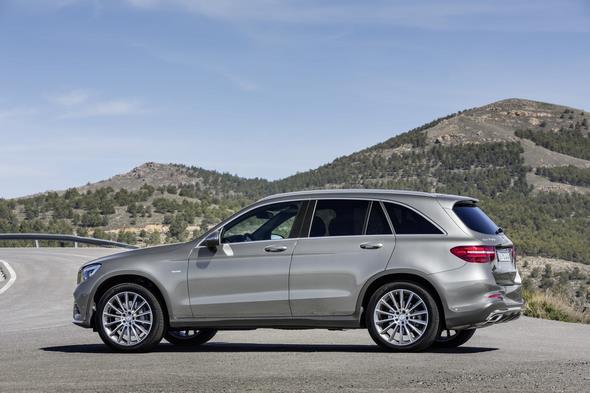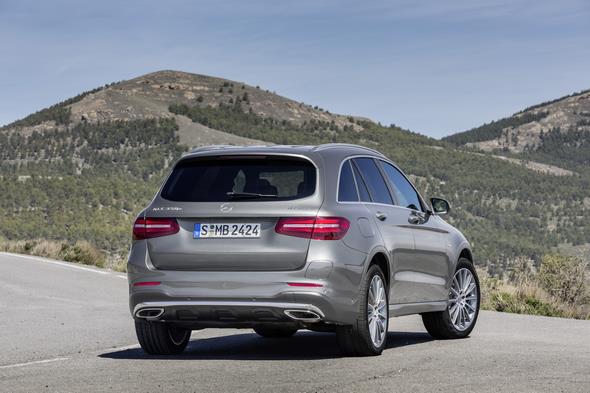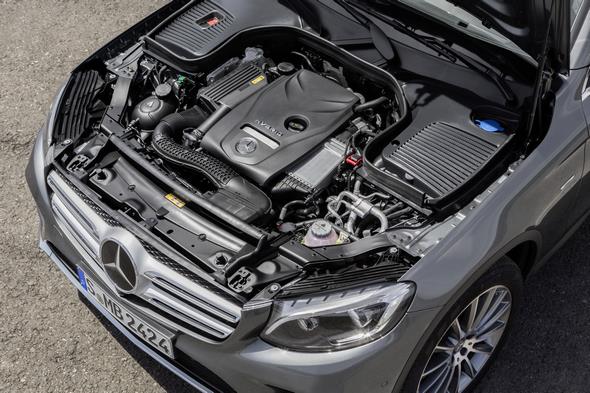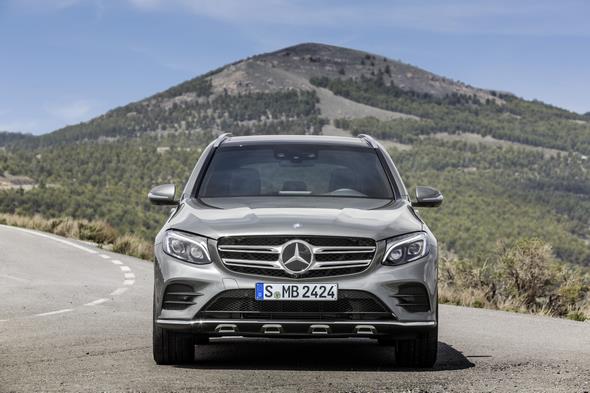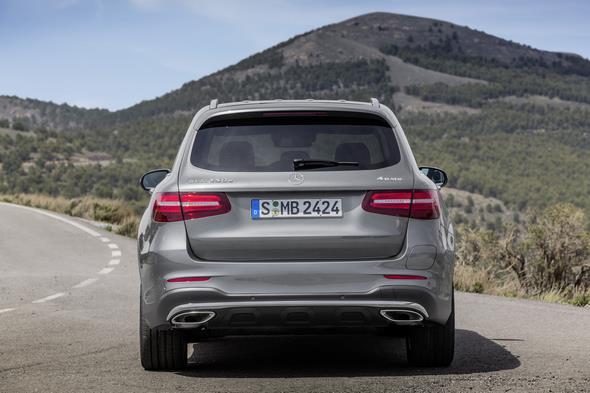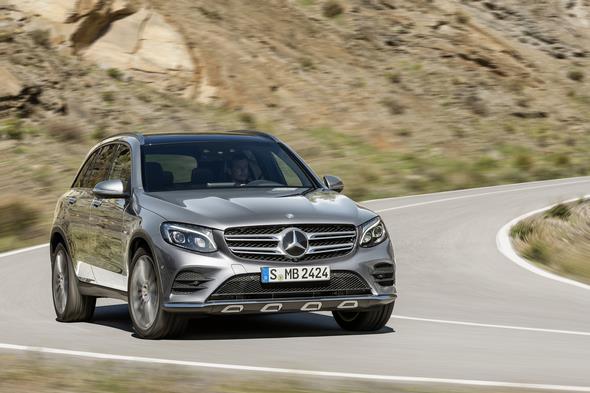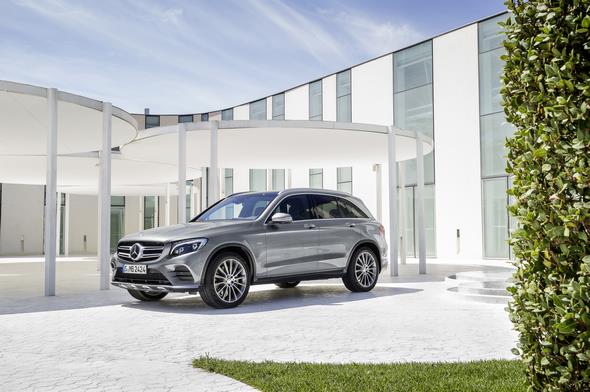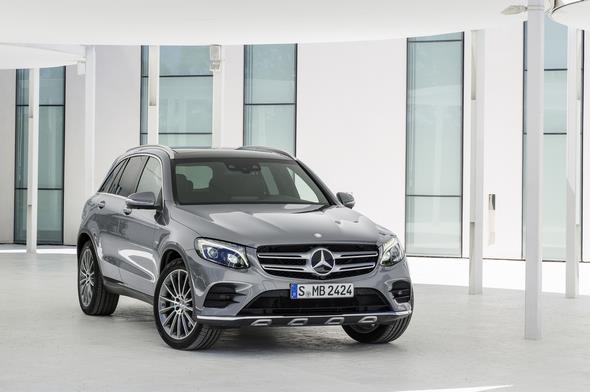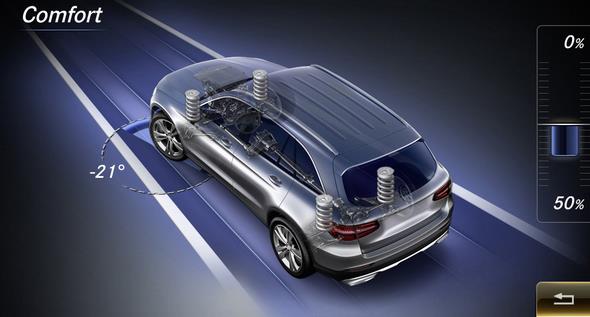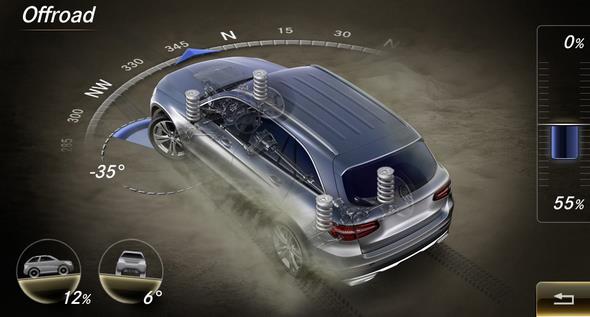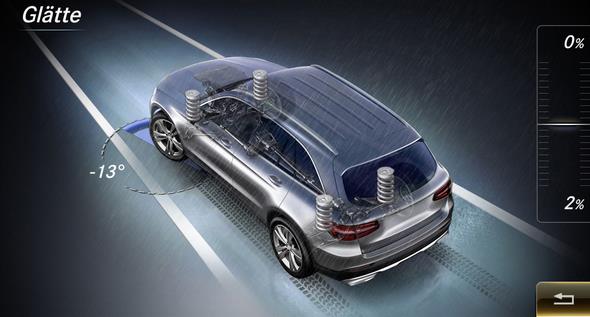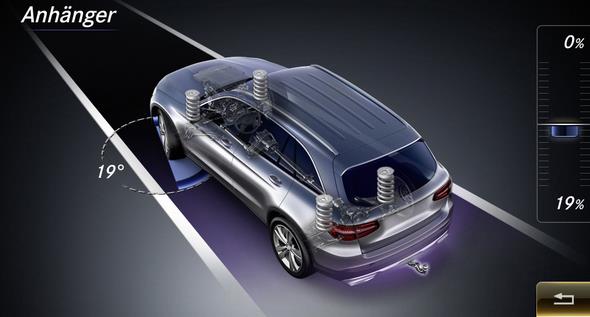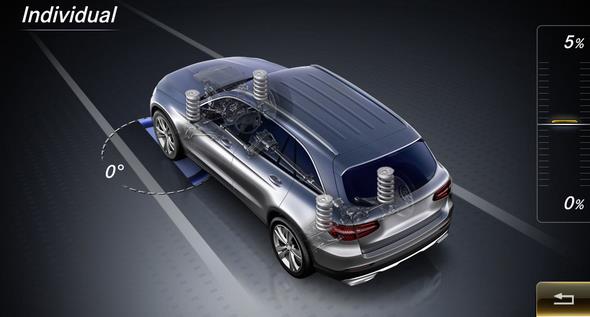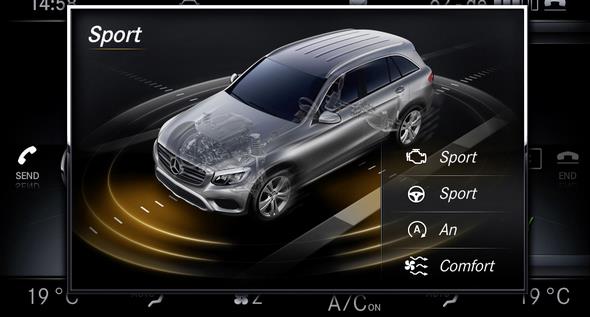Mercedes X205 GLC-Class 2015-

Encounters with the new Mercedes-Benz GLC
Second generation marks a big step forward
The new GLC is in top form. Under all operating conditions the new mid‑size SUV excels with the outstanding safety that is a hallmark
of the brand, the latest assistance systems and energy efficiency.
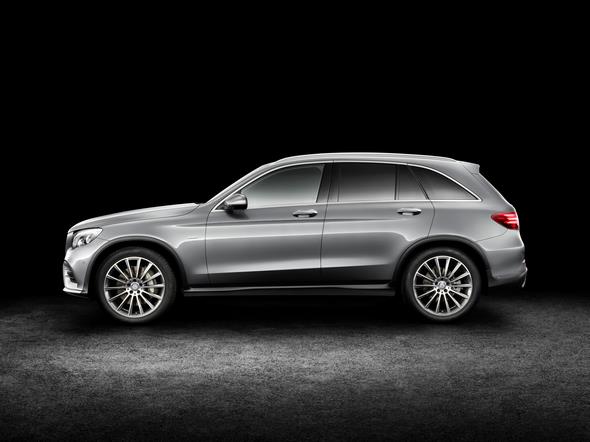
Fuel consumption has been cut by up to 19 percent compared with the previous model. At the same time, the AIR BODY CONTROL multi-chamber air suspension that is without parallel in this segment, the extended range of DYNAMIC SELECT dynamic transmission modes and the 4MATIC permanent all-wheel drive increase not only the ride comfort, but also
the vehicle’s sporty agility – whatever surface it is driving on.

“Our new GLC represents a further, systematic step in the implementation of our successful SUV philosophy.
It combines the ultimate in driving comfort with a sporty touch, impresses on the road and – more than ever – off it as well, and appeals to the eye with the new design and equipment line,” says Thomas Weber, member of the Management Board of Daimler AG and responsible for Group Research and Mercedes-Benz Cars Development.
The design philosophy behind the new GLC essentially favours sensual purity and modern aesthetics over the classic off-road look.
The dynamic design exudes emotional appeal while also employing purist forms.
Surfaces embodying a degree of tension and precise lines cite the clear design line followed by all state-of-the-art SUVs from Mercedes-Benz.
The GLC only represents a departure from its progenitor – the G-Class – in terms of appearance, however.
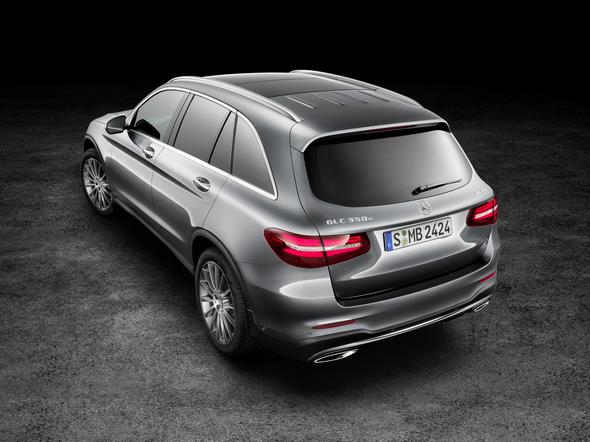
On a technical level it sets new benchmarks in all disciplines – the mid-size SUV’s off-road capabilities remain as outstanding as ever.
The paradigm shift in the area of design affects not only the outside appearance. The model change also signals a marked upgrade for the interior.
The new design idiom combines sensual purity with dynamic sportiness and embodies a new interpretation of modern luxury.
In addition, a considerably more spacious interior awaits the occupants and their luggage.
A key focus of the totally new interior design is the dashboard and the centre console with its flowing lines.
Here a large, one-piece console panel performs an elegant sweep below the semi-integrated media display from the centre air vents to the armrest.
These clear-cut lines create a feeling of open space and establish a purist, modern vibe.
The newly developed touchpad in the handrest over the rotary pushbutton nestles ergonomically in the centre console.
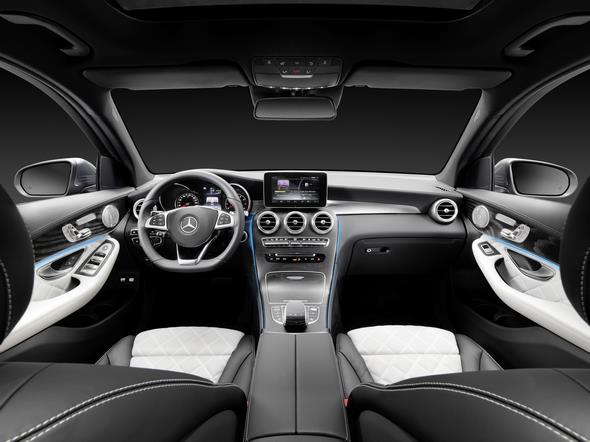
More space, more fun, more comfort
In comparison to its predecessor, the new model is substantially more spacious for front and rear occupants alike.
The increase in the length and width of the GLC by 120 millimetres and 50 millimetres respectively in comparison with the previous model has been entirely invested in the most important comfort and safety parameters.
This is further enhanced by more intelligent packaging, and in some areas the interior dimensions have increased more than the exterior dimensions:
- elbow and shoulder width +57 and +54 mm
- kneeroom in the rear +36 mm
- foot entry clearance in the rear +34 mm
- load compartment length +40 mm, min. load compartment width +150 mm
- load capacity +80 litres
- four-link front suspension +27 mm, greater ride comfort thanks to
- front module +18 mm, optimised perdestrian protection and more favourable comprehensive insurance category
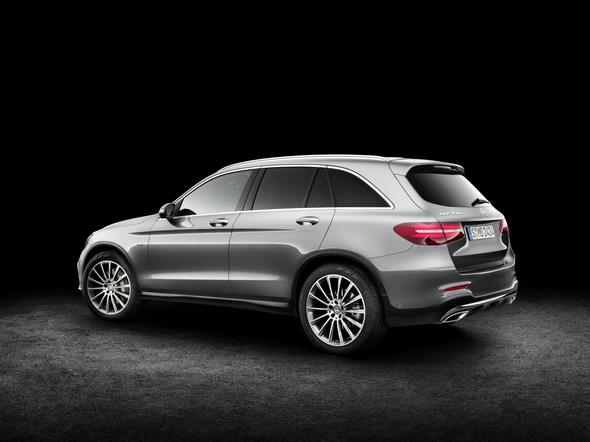
Energy efficiency: crucial parameters
Mercedes-Benz has applied an extensive package of measures to enhance the GLC’s energy efficiency and performance substantially.
Modified or new drive systems, outstanding aerodynamics and intelligent lightweight design are the primary factors behind the vehicle’s fuel efficiency.
The diesel and petrol models boast significant reductions of up to 19 percent in both fuel consumption and CO2 emissions in comparison to the previous model, while at the same time improving performance with the same power output.
The GLC 250 d 4MATIC now only consumes 5.0 – 5.5 l/100 km (129 – 143 g CO2/km).
For the first time in this segment, with the GLC 350 e 4MATIC Mercedes-Benz is additionally offering a plug-in hybrid which combines the merits of agile all-wheel drive with the lowest fuel consumption and emissions: The mid-size SUV emits only 60 g of CO2 per km* and attains a top speed of 235 km/h with a best-in-class system output of 235 kW (320 hp).
The semi-electric vehicle can cover up to 34* km in zero-emission all-electric mode, accelerating to 100 km/h in 5.9 seconds if needed, courtesy of the boost function.
* Provisional figures
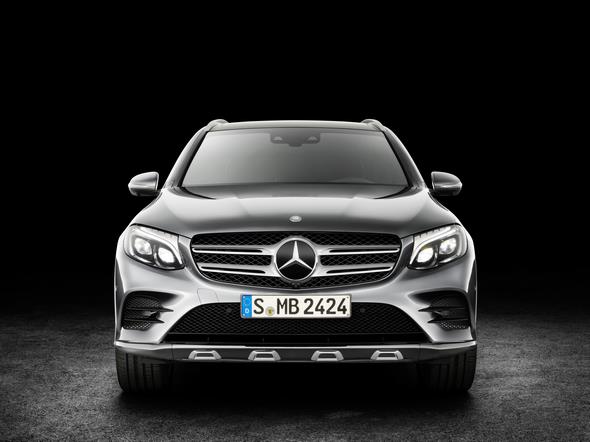
Energy efficiency: crucial parameters
The design transition has also bestowed superlative aerodynamics on the new GLC. With a Cd value of 0.31 (GLK 0.34) and total aerodynamic drag of 0.794 (GLK 0.87), it sets a clear benchmark in this segment.
Apart from the vehicle’s substantially more aerodynamically efficient basic shape, this exceptional aerodynamic performance also results from a host of solutions relating to points of detail, such as sealing of the radiator and headlamp surrounds, a radiator shutter, the extended roof spoiler or the optimised underbody panelling.
Despite markedly larger outer dimensions, a longer wheelbase and a more extensive scope of equipment, the vehicle’s weight has been cut by 80 kilograms.
The main contributory factor to this reduction is the totally new body, which is 50 kilograms lighter than the smaller GLK counterpart, thanks to an intelligent mix of materials comprising aluminium and high- to ultra-high-strength steels.
Aluminium components additionally reduce the weight of the chassis, which also benefits ride comfort due to the attendant reduction in unsprung masses.
The optional AIR BODY CONTROL full-support multi-chamber air suspension features spring elements in lightweight yet robust glass-fibre-reinforced plastic, which reduce the system weight in comparison to conventional air suspensions.
The use of the new compact transfer case as an add-on module and the 9G-TRONIC with its magnesium transmission housing results in weight reduction of 12 kg in comparison to the previous model.
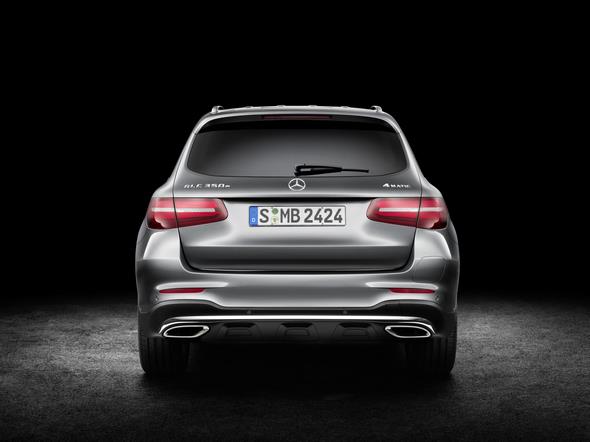
AIR BODY CONTROL: innovative air travel
The new GLC features the AGILITY CONTROL suspension with steel springs and a variable damping system as standard.
The GLC is the sole model in this market segment to offer the option of fitting the chassis with a full-support multi-chamber air suspension system and electronically controlled, continuously adjustable damping.
The AIR BODY CONTROL suspension combines excellent driving stability and sporty agility with optimum comfort and outstanding off-road capabilities.
Specific characteristics are pre-selected according to the settings of the DYNAMIC SELECT driving dynamics program.
In Sport mode the GLC’s occupants feel as if they are sitting in a sports car with a high level of lateral dynamics due to the tauter connection of the chassis, which is additionally lowered by 15 millimetres.
Comfort mode offers the very opposite ride experience, focussing on particularly comfortable running with soft connection of the chassis.
To ensure maximum driving safety in this mode, too, the spring and damper forces adapt within 60 milliseconds in response to sudden evasive manoeuvres, for example.
When the GLC is equipped with the Off-Road Engineering package, AIR BODY CONTROL optimises the wheels’ surface contact, ensuring good progress in off‑road terrain, by raising the driving level by up to 50 mm and providing for particularly soft basic tuning.
Further benefits of the system include reduced rolling during cornering, automatic level control and lowering of the load compartment sill for convenient loading and unloading.

Powertrain: agility, dynamism and comfort à la carte
The new GLC offers the DYNAMIC SELECT handling control system with five driving programs as standard.
In addition to the ECO, COMFORT, SPORT, SPORT+ and INDIVIDUAL settings which are familiar from other models, the new all-rounder can also be equipped with the Off-Road Engineering package.
This comprises up to five programs. Four off-road specific driving modes apart from “Slippery” are completely new: Offroad, Incline, Rocking with a ground clearance of up to 227 millimetres in conjunction with AIR BODY CONTROL and a trailer.
The latter facilitates moving off with an attached trailer on wet grass, for example. Like the DYNAMIC SELECT modes, all the off-road driving modes are individually depicted on the central media display.
The nine-stage 9G-TRONIC automatic transmission also comes as standard for the GLC 220 d 4MATIC, GLC 250 d 4MATIC and GLC 250 4MATIC.
Depending on the mode selected for the DYNAMIC SELECT dynamic handling control, the automatic transmission with a torque converter boasts great agility and responsiveness or poised composure.
As with all hybrid models from Mercedes-Benz, the GLC 350 e 4MATIC is equipped with the latest version of 7G-TRONIC PLUS, which has been specifically optimised in line with the needs of hybrid applications and also combines high driving dynamics with excellent drive comfort and superior efficiency.

Mercedes-Benz Intelligent Drive: guardian angels on board
Almost all of the driver assistance systems which are familiar from the C, E and S‑Class are available for the new GLC.
As part of the Intelligent Drive concept, these systems combine data from various sensor technologies to enhance comfort and safety substantially.
COLLISION PREVENTION ASSIST PLUS, Crosswind Assist, Headlamp Assist and ATTENTION ASSIST are on board as standard.
The Driving Assistance package Plus provides an even more comprehensive scope of active safety features, comprising DISTRONIC PLUS with Steering Assist and Stop&Go Pilot, PRE-SAFE® Brake with pedestrian detection, BAS PLUS with Cross-Traffic Assist, Active Blind Spot Assist, Active Lane Keeping Assist and PRE-SAFE® PLUS.
The latter feature also offers added protection in the event of a rear-end collision.
By means of a radar sensor in the rear bumper PRE-SAFE® PLUS identifies impending rear-end collisions, alerts the traffic behind by operating the hazard warning lights at a particularly eye-catching flashing frequency, activates preventive occupant protection measures and brakes the vehicle to a standstill after a rear-end collision to reduce the levels of stress acting on the occupants.
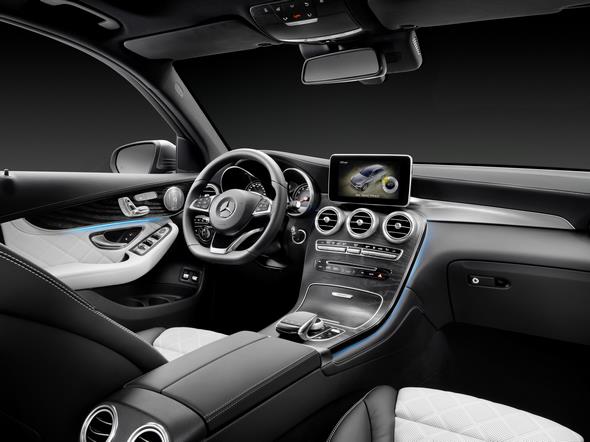
Greater safety for all road users is provided by Traffic Sign Assist with its wrong-way warning function, which in addition to speed limits can also alert the driver to no-overtaking and no-entry signs.
On vehicles equipped with the LED Intelligent Light System, Adaptive Highbeam Assist Plus allows main beam to be left on permanently by masking out the area of the main-beam light cone which is occupied by other vehicles.
Simpler handling and a clearer view when manoeuvring in tight spaces or driving in dense urban traffic are ensured by the 360° camera, which is able to show the vehicle and its surroundings from different perspectives, and by Active Parking Assist, which manoeuvres the vehicle fully automatically into detected parallel and end-on parking spaces.
The improved ergonomics and simpler controls in the GLC also help to enhance safety.
All important vehicle functions and settings can be carried out intuitively using the central rotary pushbutton or the touchpad.
The required settings or information are visualised in the large, semi-integrated colour media display in the centre of the dashboard.
Direct selection buttons next to the light switch module to the left of the steering wheel additionally enable direct activation of the most important assistance systems.
Also new is the Head-up Display (HUD). The HUD displays important information directly in the driver’s field of vision on the front windscreen, thus providing for clear legibility and less distraction from the road ahead.
The system provides information on speed, posted speed limits, navigation instructions and messages from the DISTRONIC system.
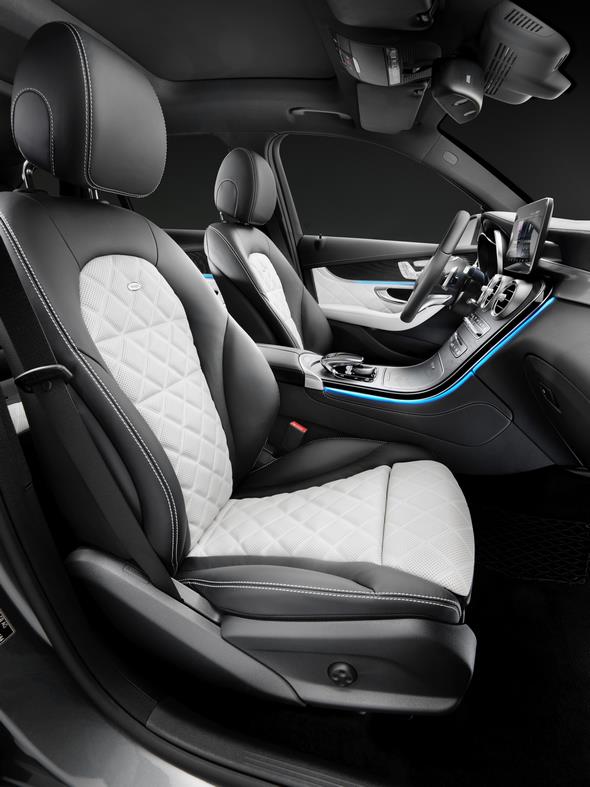
Airbag & co.: cushioning protection for the occupants
In keeping with the Mercedes-Benz tradition, the body forms the foundation for exemplary crash safety.
A high-strength safety passenger compartment forms the core of this concept.
It is surrounded by specifically designed and field-tested deformation zones, which ensure maximum safety for the occupants by virtue of optimised force paths and a combination of die-cast aluminium components and ultra-high-strength materials.
In addition to 3-point safety belts with pyrotechnical and reversible belt tensioning and belt-force limitation for driver, front passenger and those in the outer rear seats, numerous airbags serve to protect the vehicle’s occupants in an accident.
These include the combined thorax/pelvis sidebags for driver and front passenger and a newly developed windowbag extending over both seat rows, the optional sidebags for the outer rear seats and a driver kneebag.
Model range and equipment
Complete variety for individuality made to measure
Three models are available on the market launch of the new GLC, all of them equipped with 4MATIC permanent all-wheel drive and the 9G-TRONIC nine-speed automatic transmission as standard:
- GLC 220 d 4MATIC, diesel, 125 kW (170 hp)
- GLC 250 d 4MATIC, diesel, 150 kW (204 hp)
- GLC 250 4MATIC, petrol, 155 kW (211 hp)
At the end of the year the lineup will be supplemented with the new GLC 350 e 4MATIC, with which Mercedes-Benz is introducing the first plug-in hybrid into this segment.
At the same time it is the first model with permanent all-wheel drive and plug-in hybrid technology in the mid-size SUV class.
- GLC 350 e 4MATIC, plug-in hybrid, system output 235 kW (320 hp)
The GLC 350 e 4MATIC features the latest development stage of 7G-TRONIC PLUS, and combines agile all-wheel drive driving enjoyment with very low fuel consumption and emission figures.
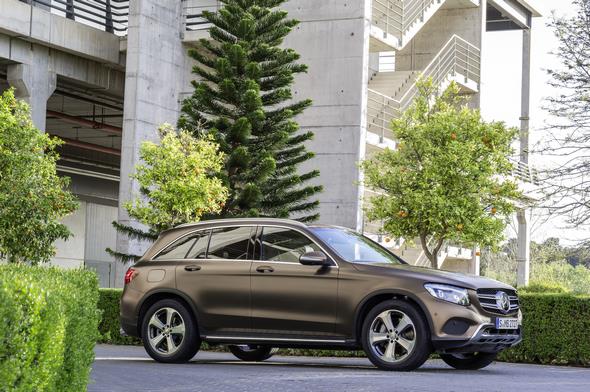
Choice of possibilities: numerous customer options rather than monotony
An unprecedentedly diverse range of equipment enables GLC customers to configure their SUV according to their own requirements and preferences.
The standard equipment already includes numerous details adopted from higher vehicle categories.
Pioneering assistance systems such as COLLISION PREVENTION ASSIST PLUS, Crosswind Assist, Headlamp Assist, ATTENTION ASSIST or an ESP® system with Dynamic Cornering Assist all feature as standard, for example.
The optional latest-generation Driver Assistance package Plus further reduces the driver’s workload while enhancing safety for the passengers, with systems including DISTRONIC PLUS with Steering Assist and Stop&Go Pilot, PRE-SAFE® Brake with pedestrian detection, BAS PLUS with Cross-Traffic Assist, Active Blind Spot Assist, Active Lane Keeping Assist and PRE-SAFE® PLUS.
DISTRONIC PLUS intelligent cruise control with COLLISION PREVENTION ASSIST PLUS and Stop&Go Pilot, the PRE-SAFE® system and Blind Spot Assist are also available separately on request.
The likewise optional Lane Tracking package combines Lane Keeping Assist and Blind Spot Assist into an advantageous package.
More safety is also ensured by the optional LED Intelligent Light System with variable light distribution, dynamic headlamp range control, the active light function and other specific light functions.
Adaptive Highbeam Assist Plus is also available in combination with these.

Adaptable: versatile driving modes and multi-chamber air suspension
The dynamic handling control system DYNAMIC SELECT with five driving modes is standard equipment for the GLC: INDIVIDUAL, SPORT, SPORT+, COMFORT and ECO.
On request the multi-talented GLC can be equipped with the Offroad Engineering package.
In addition to dynamic, real-time COMAND depictions in the media display, this offers Downhill Speed Regulation (DSR), up to five off-road driving modes (Offroad, Incline, Slippery, Rocking, Trailer), underbody protection, a special off-road light function and a 20-millimetre higher suspension level.
In conjunction with AIR BODY CONTROL the ground clearance is even increased by up to 50 millimetres.
No other model in the mid-size SUV segment is available ex factory with such a full-support multi-chamber air suspension including electronically controlled, variable damping adjustment.

Exterior styling variety: tailor-made outfit
Customers have an extensive range of options when it comes to configuring their GLC. 12 diffferent paint finishes and 15 light-alloy wheels in various spoke and design configurations up to a size of 50.8 cm (20 inches) are available.
The choice of paint finishes comprises the non-metallic black and polar white plus the metallic finishes obsidian black, cavansite blue, iridium silver, tenorite grey, diamond silver (available from 4th quarter 2015), citrine brown and selenite grey.
The three designo paint finishes citrine brown magno, diamond white bright and hyacinth red metallic are also available on request.
There are optional exterior design and equipment lines which build on the entry-level model:
- EXCLUSIVE Line with 45.7 cm (18-inch) wheels, radiator grille with twin louvres and chrome inserts, bumpers with chromed underguards at front and rear, two chromed exhaust tailpipes, polished aluminium trim and roof rails in anodised aluminium
- OFF-ROAD Line with 45.7 cm (18-inch) wheels, radiator grille with twin louvres and chrome inserts, front bumper with larger angle of approach and chromed underguard at the rear, two chromed exhaust tailpipes, polished aluminium trim and roof rails in anodised aluminium
- AMG Line with AMG 48.3 cm (19-inch) wheels, sports suspension, radiator grille with twin louvres and chrome inserts, AMG bumpers with chromed underguards, two chromed exhaust tailpipes, polished aluminium trim and roof rails in anodised aluminium
The GLC can additionally be combined with various equipment packages to lend it a yet more exclusive and individual character:
- Night package (optional in conjunction with AMG Line or EXCLUSIVE line), including exterior mirror housings and front and rear underguards in high-gloss black, window frames painted in black, roof rails in matt black, 48.3 cm (19-inch)/optionally 50.8 cm (20-inch) wheels, heat-insulating dark-tinted glass from the B-pillar rearwards and chrome louvres in the radiator grille
- Off-Road Engineering package, with the mentioned technical contents such as the five off-road driving modes and the raised suspension
(+ 20 mm, or up to + 50 mm in vehicles fitted with AIR BODY CONTROL).
Other optional extras include the large panoramic glass sliding roof with an electric roller sun blind and anti-pinch protection, aluminium-look running boards with rubber studs, the EASY-PACK tailgate with HANDS-FREE ACCESS, which can be automatically opened and closed using a swiping movement of the foot below the rear bumper, or the fully electric trailer coupling including ESP® trailer stabilisation.
Parking the GLC is made more convenient and safe by the optional Parking package: this combines Active Parking Assist with PARKTRONIC and a reversing camera, on request also with a 360-degree camera.
The reversing camera and Active Parking Assist with PARKTRONIC can also be ordered individually.
Interior styling variety: made-to-measure interior
For the interior there is a choice of various combinations in fabric, ARTICO, DINAMICA, leather or nappa leather in black, silk beige, espresso brown, saddle brown and platinum white pearl (designo only).
Customers can combine these upholstery options with light longitudinal-grain aluminium trim, optionally in combination with AMG carbon-fibre trim or wood elements in brown or black open-pore ash, linestructure lime wood in high-gloss brown, burr walnut wood in high-gloss brown or a black piano-lacquer look.
Variations are also available for the roof liner, which comes in black, crystal grey or porcelain.
As standard the GLC has an excellent infotainment system for the occupants, thanks to a high-resolution 17.8 cm (7-inch) colour media display and the Audio 20 USB sound system with Frontbass and an integrated Bluetooth® interface with an HD voice-capable hands-free function and audio streaming for playing music files.
In the centre armrest there are two USB connectors for external audio devices and data media. In conjunction with a Bluetooth®-capable smartphone with a data option the system is already internet-capable.
This enables the internet to be surfed without restrictions when the vehicle is stationary.
The same applies to Audio 20 CD, which features an additional CD drive compared to Audio 20 USB. This is also able to play MP3, WMA, AAC and WAV files.
The optional Garmin® MAP PILOT expands Audio 20 CD into a fully-fledged navigation system integrated into the onboard electrical system.
The navigation software and map data are supplied on an SD card.
Musical enjoyment at concert hall level is possible with the Burmester® surround sound system. This has a 9-channel DSP amplifier, 13 speakers and a system output of 590 watts.
When COMAND Online is installed, the media display increases in size to 21.3 cm (8.4 inches) and has a higher resolution of 960 x 540 pixels.
It features a specially bonded glass cover familiar from consumer devices such as the iPhone® or iPad®.
It also allows digital TV/radio reception, for example, and offers a host of other features including fast hard-disc navigation, automatic tailback avoidance via up-to-date and accurate “Live Traffic Information”, an integrated WLAN hotspot functionality and the LINGUATRONIC voice-operated control system.
In conjunction with COMAND Online, Mercedes-Benz Apps such as Weather, GoogleTM Local Search with StreetView and Panoramio, destination/route download and Facebook can be used while on the move.
Audio and video playback is possible from various sources. For example, via Bluetooth®, from an Apple iPod® or iPhone®, from an SD card, USB stick or CD/DVD (with Audio 20 CD or higher and with COMAND Online).

Mercedes connect me: your personal assistant
Following on from the models of the C-, E- and S-Class, Mercedes connect me is also available for the GLC.
In addition to the standard functions such as eCall, accident recovery, breakdown assistance or after-sales service, the Remote Online app (standard with COMAND Online) offers numerous convenience features via smartphone, such as tracking to locate the parked vehicle, control of the auxiliary heating, locking and unlocking of the vehicle or the retrieval of various items of information, such as odometer reading, fuel level or range.
Touchpad: easy and intuitive operation by finger gestures
The innovative 65 x 45-millimetre touchpad developed by Mercedes-Benz in the handrest above the controller on the centre tunnel marks a further evolutionary step in operating convenience.
It is automatically included if COMAND Online is specified, and optional in conjunction with Audio 20.
As with a smartphone, the touchpad can be used by the driver and front passenger to operate all head unit functions very easily and intuitively using single or multi-finger gestures (Multitouch).
Slow and fast gestures are possible. The touchpad also permits letters, numbers and special characters to be entered in handwriting – in any language supported by Audio 20 or COMAND Online.
The user receives clear tactile feedback when operating the touchpad’s control surface, which is highly conducive to really intuitive use.
Newly available, the head-up display (HUD) projects relevant information onto the windscreen directly in the driver’s field of vision, ensuring good legibility and little distraction from the traffic situation.
The HUD indicates the vehicle speed and – depending on the level of equipment – also shows speed limits, navigation instructions and information relating to assistance systems.
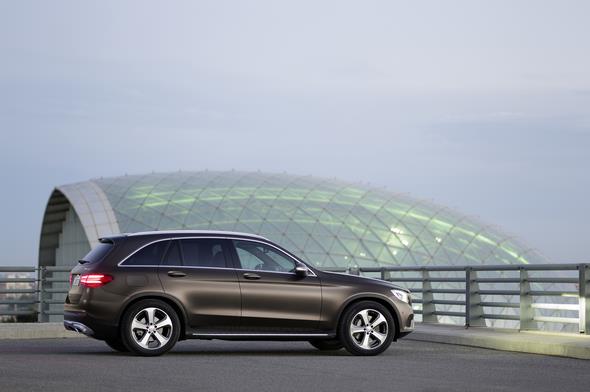
Upgrading: additional equipment lines extend the interior options
As is the case for the exterior, a choice of design and equipment lines is also available for the interior:
- EXCLUSIVE line, including upholstery in ARTICO man-made leather/fabric, ARTICO-covered dashboard with contrasting topstitching, seats featuring an exclusive upholstery layout, Interior Light package, wood trim in high-gloss brown linestructure lime and the 3-spoke multifunction steering wheel
- AMG Line, including upholstery in ARTICO man-made leather/DINAMICA microfibre, seats with an exclusive upholstery layout, Interior Light package, 3-spoke multifunction steering wheel with flattened bottom section, trim in light longitudinal-grain aluminium in the doors and black piano-lacquer look in the centre console, AMG sports pedals
Two different designo lines are additionally available:
- designo interior – two-tone: Seats in two-tone platinum white pearl/black designo nappa leather with contrasting topstitching, trim in black open-pore ash in the centre console and longitudinal-grain aluminium in the doors
- designo interior – black: Seats in black designo nappa leather, trim in high-gloss brown linestructure lime
Interesting and popular individual features for the interior include multi-colour ambient lighting, the AIR BALANCE package with ionisation and fragrancing, a heated multifunction steering wheel, the heated front seats with fully electric adjustment, heated rear seats and THERMOTRONIC automatic climate control.
Heat and noise-insulating acoustic glass is available for the front doors.
The stowage facility package keeps things neat and tidy with rolled-up fluorescent jackets in the front door panels, map pockets on the rears of the front seats, a net on the luggage compartment floor, folding box, cargo clamp, lockable luggage compartment floor, 12 V power socket and electric release of the rear seat backrests next to the rear bench seat.
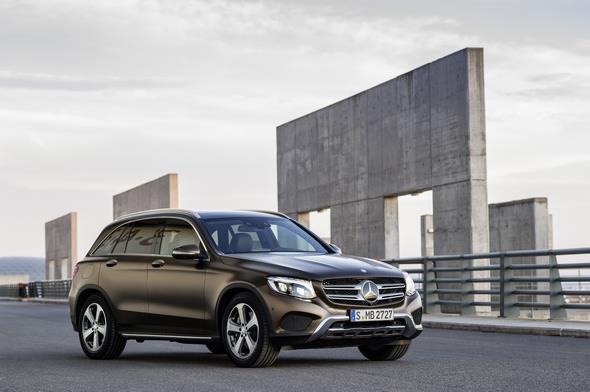
On market launch: Mercedes-Benz GLC Edition 1
A particular favourite which has now become something of a tradition is the Edition 1 model.
On market launch the special edition of the GLC will be available in a choice of two different interior variants – designo black or designo two-tone.
The two-tone version has the AMG sports steering wheel, and both have ambience lighting, a black roof liner and the Seat Comfort package with heated front seats. Externally both GLC Edition 1 variants impress with the exclusive features of the AMG Line Exterior.
This comprises 50.8 cm (20-inch) multi-spoke AMG wheels in titanium grey, sports suspension, twin-pipe exhaust system, dark-tinted heat-insulating glass from the B-pillar rearwards, polished aluminium trim and roof rails in anodised aluminium.
As is traditional, the special model is recognisable by the “Edition 1” lettering on the front wings and on the trim in the centre console.
The GLC Edition 1 can be combined with all paint finishes and engine variants.The price for the Edition 1 equipment package is € 8211 incl. VAT.
Overview of key standard equipment in the GLC
The new GLC has a high level of standard equipment. this includes the following
for all models:
- 9G-TRONIC including DIRECT SELECT level and DIRECT SELECT steering wheel shift paddles (7G-TRONIC PLUS for GLC 350 e 4MATIC)
- Cruise control with SPEEDTRONIC variable speed limiter
- DYNAMIC SELECT with five driving modes
- AGILITY CONTROL suspension with selective damping system
- Direct-Steer system with speed-sensitive power assistance and variable steering ratio
- ECO start/stop function
- 2 cm (17-inch) 10-spoke light-alloy wheels painted in vanadium silver with 235/65 R17 tyres
- ADAPTIVE BRAKE with HOLD function, Hill-Start Assist, priming and dry braking in the wet
- ATTENTION ASSIST is able to recognise typical signs of drowsiness by monitoring steering behaviour, and can warn the driver of potential microsleep
- COLLISION PREVENTION ASSIST PLUS including Adaptive Brake Assist and autonomous partial braking to prevent collisions or mitigate their severity
- Electronic Stability Program (ESP®) with Crosswind Assist and Dynamic Curve Assist
- Pedestrian protection with active bonnet
Standard equipment in the interior of the GLC:
- A total of seven airbags
- ISOFIX child seat attachment system with Top Tether in the rear
- Mercedes-Benz emergency call system
- Front seats partially electrically adjustable
- Rear seat-belt status display in the instrument cluster
- Folding rear seat backrests 40/20/40 division,
luggage capacity 550 litres - Front door sill panels with “Mercedes-Benz” lettering
- Trim in black piano lacquer look
- 3-spoke multifunction steering wheel in black leather,
- THERMATIC automatic air conditioning with 2 climate zones, separate temperature control for driver and front passenger, activated charcoal dust filter to reduce fine particles and odours, air recirculation switch with comfort function, sun and dewpoint sensor, rear ventilation nozzles
- Heat-insulating glass green-tinted all-round including rear window of single-pane safety glass
- Communication module for the use of Mercedes connect me services, preparation for the use of Mercedes connect me services
- Audio 20 multimedia system with high-resolution 7-inch colour media display, central control panel on the centre console, radio with twin tuner and traffic report decoder (TP/TA), 2 USB connectors in the centre armrest for external audio devices and data media (iPod®, iPhone®capable, access via onboard control concept), Bluetooth® interface with HD voice-capable hands-free function and audio streaming for playing music files, Cover Flow and Cover Art to show album covers, SMS display function, internet capability
- Loudspeakers with Frontbass
- Bluetooth® interface with hands-free function
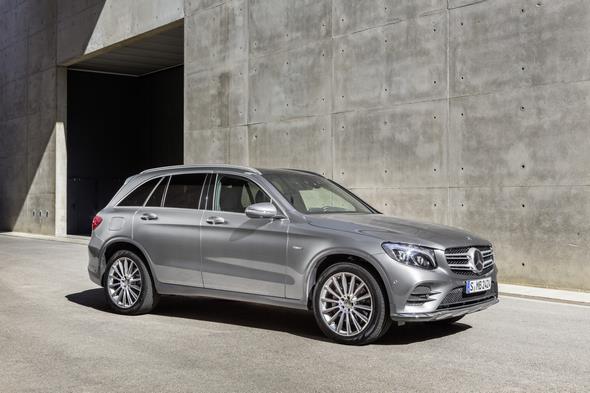
Highlights of the optional extras for the GLC
In addition to the equipment packages, the GLC can be upgraded with numerous optional extras, for example:
- AIR BODY CONTROL air suspension with continuously variable damping
- Offroad Engineering package including Downhill Speed Regulation (DSR), with up to 5 off-road driving modes and underbody protection of GEMTEX, suspension raised by 20 mm compared to standard suspension
- Panoramic glass roof with electric roller sunblind and anti-pinch protection
- Roof rails of anodised aluminium, flush-mounted
- Trailer coupling with ESP® trailer stabilisation and fully electrically pivoting ball head
- Aluminium-look running boards with rubber studs
- Light-alloy wheels
- 7 cm (18-inch) with 235/60 R18 tyres
- 3 cm (19-inch) with 235/55 R19 tyres
- 8 cm (20-inch) with 255/45 R20 tyres
- Driving Assistance package Plus including DISTRONIC PLUS with Steering Assist and Stop & Go Pilot, PRE-SAFE® Brake with pedestrian recognition, BAS PLUS with Cross-Traffic Assist, Active Blind Spot Assist, Active Lane Keeping Assist and PRE-SAFE® PLUS
- Parking package including Active Parking Assist with PARKTRONIC and reversing camera, optionally with 360º camera
- Adaptive Highbeam Assist Plus
- LED Intelligent Light System with variable light distribution, active light function, country and motorway modes, cornering lights, extended fog light function, dynamic headlamp range control and blue welcome light
- Ambience lighting in the front under the trim and in the doors, rear footwell lights, three colours available, door sills with Mercedes-Benz lettering, illuminated in the front, cupholder lighting, exit and warning lights in the doors
- Seating Comfort package for driver and front passenger consisting of: electro-pneumatic 4-way lumbar support with control on the seat, electric seat cushion inclination adjustment, mechanical seat cushion fore/aft adjustment
- Climatised seats for the driver and front passenger, including heating and ventilation
- Multifunction steering wheel, heated
- THERMOTRONIC automatic air conditioning with 3 climate zones including residual engine heat utilisation, activated charcoal filter for reduction of fine particles and odours, separately adjustable temperature for driver, front passenger and rear occupants, individual climate modes FOCUS, MEDIUM, DIFFUSE, air quality sensor with automatic air recirculation, dewpoint sensor, control panel in rear with temperature control and booster fan for rear ventilation
- AIR-BALANCE package including ionisation, improved air filtering and fragrancing
- Head-up display
- Seat heating in the rear
Design
The new SUV look
The design philosophy behind the new GLC essentially favours sensual purity and a modern aesthetic over the classic off-road look of its predecessor, the GLK.
The dynamic design exudes emotional appeal while also employing purist forms.
Surfaces embodying a degree of tension and precise lines cite the clear design line followed by all state-of-the-art SUVs from Mercedes-Benz.
The GLC only represents a departure from its progenitor – the G-Class – in terms of appearance, however.
On a technical level it sets new benchmarks in all disciplines – the mid-size SUV’s off-road capabilities remain as outstanding as ever.
Gorden Wagener, Head of Design at Daimler AG:”At Mercedes-Benz, intelligence always goes hand-in-hand with emotion.
With our design philosophy, the GLC generates emotional appeal while at the same time displaying a marked increase in functionality.
The high-quality interior now offers substantially more space for the occupants and their luggage while also boasting fine materials and exuding a progressive sportiness.”
The body fundamentally follows the sensual, clear design philosophy that was so successfully demonstrated with the Concept GLC Coupé showcar.
“All forthcoming SUVs will follow our design philosophy of Sensual Purity and take on a markedly sportier character.
And, like the GLA and the new GLE Coupé, they will embody the modern luxury of our brand,” says Gorden Wagener to outline the design future at Mercedes-Benz.
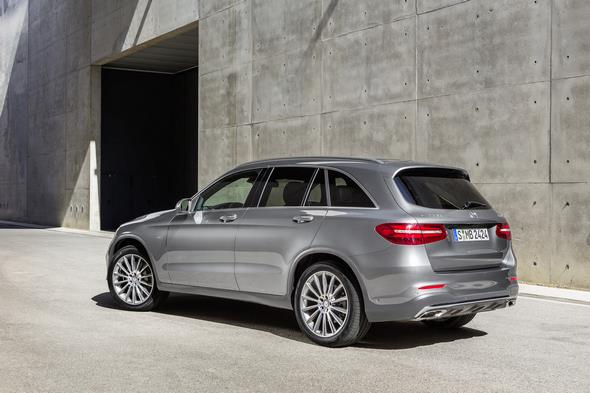
From a single mould: front, side aspect and rear
The characteristic SUV front with a short, succinct overhang, upright, three-dimensional radiator grille with a twin louvre and centrally positioned brand star follows the successful new design line.
Striking headlamps, optionally available as LED High Performance lamps, lend the GLC a self-confident look which is further emphasised by their distinctive night design.
The bumpers with integrated underguard come in three variants: in addition to the base version there is a version optimised for off-road use with a larger angle of approach/departure, plus a particularly sporty AMG variant.
The side view showcases the almost coupé-like greenhouse, which together with the 118 millimetres larger wheelbase lends the GLC an elegant long profile.
This impression is further reinforced by the gently sloping dropping line which is a hallmark of the brand and by the powerful shoulders.
The rising lower feature line also enlivens the vehicle’s side view. Matt black cladding in the wings, wheels up to a size of 50.8 cm (20 inches) and the optional side running board provide clear indications of the GLC’s off-road credentials.
The rear is characterised by the broad, muscular shoulders, the horizontal orientation of the contour lines and the split LED rear lamps featuring a distinctive night design.
As on the front, the different bumper variants are available here as well. By integrating all the antennae into the exterior mirrors and the roof spoiler, it has been possible to do away with the fin which has featured on the roof to date.
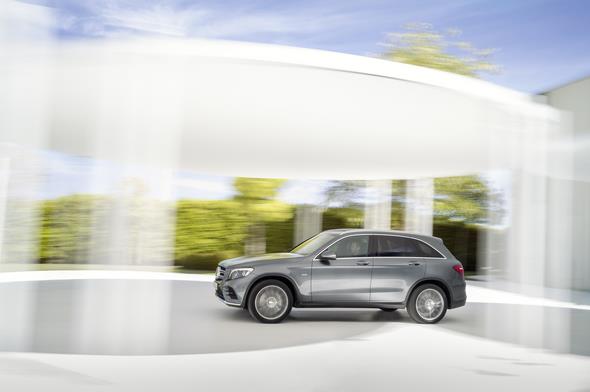
GLC interior: added class
The paradigm shift in the area of design affects not only the outside appearance. The model change also signals a marked upgrade for the interior.
“With its modern design idiom, the GLC also showcases our passion for the SUV genre through the sporty character of its interior.
The finest materials, authentic trim and innovative infotainment systems conjure up a hallmark Mercedes-Benz luxury setting.
“This means that the occupants of the GLC experience contemporary luxury at a level previously unattained in this vehicle category,” Gorden Wagener continues.
The new design idiom combines sensual purity with dynamic sportiness and embodies a new interpretation of modern luxury.
The GLC’s interior conjures up the feel-good atmosphere which is a brand hallmark courtesy of high-class materials featuring a hand-crafted character, such as nappa leather or open-pore wood trim, meticulously finished details and an appealing overall touch and feel.
Last but not least, substantially more space is available for occupants and luggage. The optional large-area panoramic glass roof further enhances the light and airy feel inside.
A key focus of the totally new interior design is the dashboard and the centre console with its flowing lines, with a large, one-piece console panel performing an elegant sweep from the centre air vents to the armrest.
These clear-cut lines create a feeling of open space and establish a purist, modern vibe.
The newly developed innovative touchpad in the handrest over the rotary pushbutton nestles ergonomically in the centre console.
As on a smartphone, this provides for very simple and intuitive operation of all the head-unit functions using finger gestures.
The touchpad also permits letters, numbers and special characters to be entered in handwriting – in any language supported by Audio 20 or COMAND Online.
A centrally positioned media display is partially integrated above the centre console.
Five round air outlets with metallic “cool touch” effect lend the dashboard a sporty air and create an interesting contrast to the warm look of the other materials.
Comfort and space
More space, more fun, more comfort
In comparison to its predecessor, the new GLC is substantially more spacious for front and rear occupants alike.
The increase in the size of the GLC in comparison to the previous model has been translated effectively into useful interior space.
Almost all key comfort factors have been improved – substantially in some instances – above all the space on the rear bench, which came in for frequent criticism on the previous model.
An impressive amount of legroom – the space between the front seat backrests and the rear bench seat – is now available, following a very sizeable increase of 57 millimetres.
More space is also available for the front occupants, who benefit from a generous increase in shoulder and elbow room.
By means of intelligent packaging and perfect seat geometry, the interior designers from the Mercedes-Benz Technology Centre (MTC) have even managed to conjure up 57 millimetres of additional space here – although the vehicle’s width has only grown by 50 millimetres.
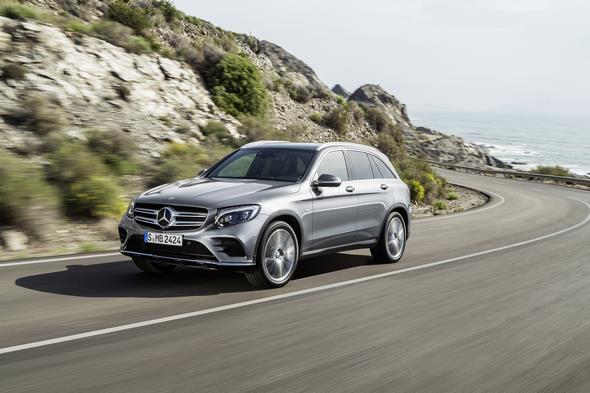
Comparison of dimensions:
| GLK | GLC | ∆ | |
| Basic body dimensions (mm) | |||
| Wheelbase | 2755 | 2873 | +118 |
| Track front/rear | 1574/1597 | 1621/1617 | +47/+20 |
| Length | 4536 | 4656 | +120 |
| Width | 1840 | 1890 | +50 |
| Height | 1630 | 1639 | +9 |
| Interior dimensions (mm) | |||
| Centre of front wheel to SRP 1 | 1527 | 1567 | +40 |
| SRP distance, driver to rear | 808 | 846 | +38 |
| Effective legroom in rear | 891 | 948 | +57 |
| Elbow room in front | 1442 | 1499 | +57 |
| Elbow room in rear | 1440 | 1474 | +34 |
| Shoulder room in front | 1401 | 1455 | +54 |
| Shoulder room in rear | 1408 | 1436 | +28 |
| Max. headroom, front | 1057 | 1065 | +8 |
| Max. headroom, rear | 1012 | 1005 | -7 |
Another comfort criterion – entry and exit space for the rear passengers – has also been enhanced substantially, with 34 millimetres more foot space now available for the purposes of entering and exiting the vehicle.
Growth strategy applied to maximum effect
Through the effective use of space and intelligent packaging, the engineers have also managed to increase the size of the luggage compartment with a level load area and its attendant utility value substantially.
| GLK | GLC | ∆ | |
| Load compartment dimensions | |||
| Min. luggage compartment capacity, l | 420 – 470 | 550 | +80 – 130 |
| Max. luggage compartment capacity, l | 1550 | 1600 | +50 |
| Max luggage compartment length, mm | 890 | 930 | +40 |
| Max. luggage compartment width, mm | 1261 | 1389 | +128 |
| Min. luggage compartment width, mm | 950 | 1100 | +150 |
| Rear seat backrest variability/split | 60/40 | 40/20/40 | – |
| Cargo position | no | yes | – |
Added convenience for loading and unloading is provided by lowering of the load compartment sill in conjunction with the AIR BODY CONTROL option and by HANDS FREE ACCESS, which enables the tailgate to be opened automatically by performing a swiping movement with the foot under the bumper.
NVH: no noise, no vibration, no harshness
In order to assess the aeroacoustics, which represent the crucial comfort parameter particularly at higher speeds, the development engineers examined the GLC’s psycho-acoustic properties.
In addition to the high-frequency wind noise, the low-frequency components and, in particular, speech intelligibility are considered and optimised here.
In their development work, the engineers devoted special attention to the air flow around the body of the vehicle, the sealing systems at doors and windows and the bodyshell.
The focus in this work is not solely on the absolute sound pressure level (dB(A)). Rather, the onus is on creating the most homogeneous, harmonious possible overall acoustics.
This means that neither certain frequency ranges nor individual components or areas of the vehicle must be allowed to play a dominant role.
From a speed of around 120 km/h, wind noise is the dominant acoustic factor, while tyre and engine noise play a less important role.
A comparison with the E-Class shows how successfully the aeroacoustics engineers have “tuned” the GLC. The wind noise index, WI – a dimensionless figure to classify aeroacoustic quality – is at the same pleasant level in both objective and subjective terms.
In addition to an increase in the vehicle’s overall rigidity, another key focus of development work was on connection of the chassis and drive system to the body, as high introduction rigidity of the mounting points is essential in order to tune the bearing elements so as to minimise the noise level.
The development engineers at the Mercedes Technology Centre have pulled out all the stops here, and achieved a further marked reduction in noise and vibration.
In addition to the aeroacoustic measures, the following components and design details are also conducive to noise and vibrational comfort:
- Low noise input into the interior as a result of the intelligent use of sprayable acoustic compositions in the body-in-white, major assemblies compartment partition made of fibre-reinforced plastic with absorber, firewall insulation with high-quality injection moulded component
- Rigid front-end design with diagonal struts and a new front module concept consisting of an extruded section and cast aluminium/plastic consoles with additional struts. To date, this design has only been applied for convertibles, which entail special requirements in this area.
- Rigid cockpit cross-member consisting of high-strength magnesium alloy
- Electro-mechanical Direct-Steer system with optimised housing rigidity and body connection reduces steering and tyre noise.
- Highly sound-absorbent acoustic windscreen, acoustic front side windows optionally available
- Three-point engine mounting damps resonant vibrations and reduces the forces introduced into the body
- Body floor with reinforced tunnel, additional beading and reinforcements in the area of connection of the transmission; reduces tyre noise and eliminates vibration of the main floor and the attendant noise radiation
- High rigidity of the rear area thanks to the use of cast aluminium components
- Reduction in unsprung masses as a result of weight-optimised aluminium components and the use of glass-fibre reinforced spring elements when AIR BODY CONTROL air suspension is fitted
Minimal torsional vibration by virtue of centrifugal pendulum and double turbine damper (9G-TRONIC) or double torsional damper (7G-TRONIC PLUS in the 350 e 4MATIC)
Energy efficiency
Economy on four wheels
A revised all-wheel-drive powertrain, the outstanding aerodynamics and the intelligent lightweight design are the primary reasons for the high energy efficiency of all the new GLC models.
The conventional diesel and petrol models boast significant reductions of up to 19 percent in both fuel consumption and CO2 emissions in comparison to the previous generation, while at the same time improving performance.
| GLC 220 d 4MATIC | GLC 250 d 4MATIC | GLC 250 4MATIC | |
| Output, kW/hp | 125/170 | 150/204 | 155/211 |
| Torque, Nm | 400 | 500 | 350 |
| Fuel consumption, l/100 km | 5.0 – 5.5 (6.1 – 6.5) | 5.0 – 5.5 (6.1 – 6.6) | 6.5 – 7.1 (7,5 – 7,9) |
| ∆ Consumption % | -19 | -19 | -12 |
| CO2 g/km | 129 – 143 (159 – 169) | 129 – 143 (159 – 169) | 152 – 166 (173 – 180) |
| ∆ CO2 g/km % | -19 | -19 | -12 |
| 0-100 km/h | 8.3 (8.5) | 7.6 (8.0) | 7.3 (7.9) |
| Vmax km/h | 210 (205) | 223 (210) | 223 (215) |
() Figures for the previous model
Mercedes-Benz is also offering a plug-in hybrid for the first time in this market segment: The GLC 350 e 4MATIC boasts minimal fuel consumption and emissions while offering performance on a par with that of a sports car.
It is also the first plug‑in hybrid in this market segment with permanent all-wheel drive, which also performs convincingly off-road.
This version supersedes the previous GLK 350 4MATIC model with a conventional petrol engine and similar performance data.
A comparison of fuel consumption, emissions and performance reveals the superiority of the plug-in hybrid concept particularly vividly:
| GLK 350 4MATIC | GLC 350 e 4MATIC | ∆ % | |
| Output, kW/hp | 225/306 | 235 / 320* | +4.6 |
| Torque, Nm | 370 | 560* | + 51.4 |
| Fuel consumption, l/100 km | 8.1 – 8.6 | 2.6 | – 70 |
| CO2 g/km | 189 – 199 | 60 | – 70 |
| 0-100 km/h | 6.5 | 5.9 | – 9.2 |
*System output
In addition, the GLC 350 e 4MATIC can cover up to 34 km in zero-emission all-electric mode, with a top electric speed of 140 km/h.
And thanks to optimised integration of the plug-in technology it furthermore offers outstanding cargo space for a plug-in hybrid at 395 / 1445 litres.
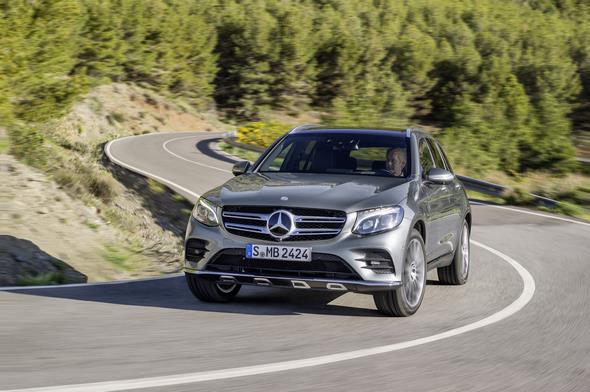
Individual solutions for maximum efficiency
Compared to its competitors, Mercedes-Benz is taking a very individual approach with its plug-in hybrids.
The decisive difference is this: the electric motor in the transmission bell housing between the internal combustion engine and 7G-TRONIC is connected to the transmission’s input shaft, and not to the crankshaft of the internal combustion engine as is usual.
This means that the wet clutch which inherently replaces the hydrodynamic torque converter can cope with all operating situations.
A further clutch to disengage the electric motor from the transmission is unnecessary, increasing the energy efficiency of the entire hybrid system:
- when the GLC 350 e 4MATIC is driving fully electrically, the wet clutch is disengaged while the internal combustion engine is decoupled and switched off.
- The clutch likewise remain disenaged during energy recuperation, the electric motor acting as a generator and using the GLC’s flywheel mass to charge the battery.
- The wet clutch is engaged during boost and sailing operation, or in CHARGE mode, and the intelligent hybrid control system actuates the electric motor according to current power requirements.
- The clutch remains engaged when driving with the internal combustion engine alone, and the intelligent hybrid control system switches the electric motor to free-running mode.
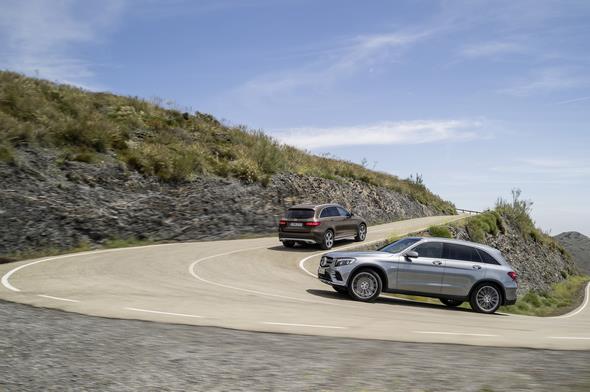
Just like its plug-in big brother in the S-Class, the GLC 350 e 4MATIC offers all the characteristic comfort and efficiency systems. The most important facilities at a glance:
- Silent start: the vehicle starts virtually silently and runs in electric mode. At this point the combustion engine is generally kept switched off.
- Boosting: The electric motor kicks in to boost the output of the combustion engine by up to 85 kW, turning the GLC 350 e 4MATIC into a sports car. Acceleration from 0 to 100 km/h takes only 5.9 seconds.
- Energy recuperation: Energy is recovered during braking, and fed to the battery. This energy can then be used at a later stage for electric driving or the boost function.
- Haptic accelerator pedal: Supports fuel-efficient driving. A resistance point indicates the maximum available electric output. A double impulse signals that the driver should remove their foot from the accelerator pedal in order to switch off the combustion engine and decouple it from the drive train.
- Intelligent HYBRID: Intelligent operating strategy for hybrid vehicles, anticipates the course of the road and the traffic situation for maximum efficiency. This includes radar-based recuperation, an anticipatory shifting and operating strategy, a route-based operating strategy and ECO Assist
- Pre-entry climate control: The desired interior climate can be set before starting your journey – cooling in the summer, heating in the winter. This function can be activated via a pre-set departure time or via smartphone using the Mercedes connect me app.
- Retrieval of vehicle status: It is additionally possible to control the charging process or to check the charge status and the current electric range via the Mercedes connect me app

The GLC 350 e 4MATIC offers four basic operating modes which are available in the DYNAMIC SELECT driving programs ECO and COMFORT:
- Hybrid: All hybrid functions, such as electric mode, boost and recuperation are available and are deployed for optimum fuel efficiency.
- E-mode: used for all-electric driving – for example in inner-city areas or because the battery holds sufficient charge for the remainder of the journey.
- E-Save: the charge status of the battery is maintained – for example to allow all-electric driving in an environmental zone at a later stage in the journey.
- Charge: Serves to charge the battery via the combustion engine while on the move, to enable all-electric driving in an environmental zone at a later stage in the journey, for example.
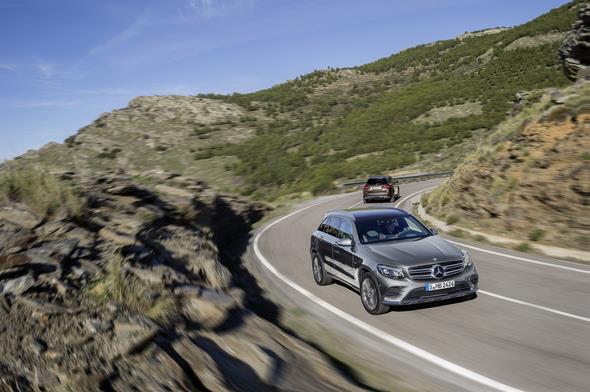
Intelligent lightweight design for slimline results
Another key factor behind the vehicle’s economic efficiency is the weight-shedding programme that the GLC has undergone.
Despite markedly increased exterior dimensions, a longer wheelbase and more equipment, the vehicle’s gross weight has dropped by 80 kilograms.
The main contributory factor here is the totally new aluminium hybrid body, which introduces innovative lightweight design into volume production.
The GLC’s structure is based on an intelligent mix of materials spanning aluminium, high to ultra-high-strength steels and robust plastic.
Including the doors and door hinges weighing a total of 476.5 kilograms, the bodyshell is around 50 kilograms lighter than the more compact preceding model – and remarkably, this is accompanied by increased rigidity for outstanding handling, optimised noise and vibration comfort and even better crash safety.
The following aluminium components are used, accounting for 13 percent of the weight:
- front wing, bonnet and roof panelling
- Front: front end (extruded aluminium section), crash boxes, frames for fitting headlamps, cooling system and bonnet closing system
- shock absorber strut consoles (die-cast aluminium) to house the front struts
- rear area with shock absorber strut consoles, cross-members and longitudinal members (die-cast aluminium)
- door hinges
- 4×4 integral support for front axle and steering, rear axle carrier
- Suspension: four-link front suspension with spring link, strut rod, upper wishbone and steering knuckle (forged aluminium), five-link rear axle and wheel carrier (forged aluminium). This lowers the weight of the rear axle by 5 kilograms, while also improving its stability.
The steel grades used are distributed as follows:
- 59 percent by weight of high-strength and very high-strength steel
- 17 percent of ultra-high-strength steel
- 11 percent of even more resistant, hot-formed steel
Weight-shedding measures also apply to the air suspension elements of the AIR BODY CONTROL system, which consist of glass-fibre-reinforced plastic.
The aluminium and plastic components of the chassis and suspension not only reduce the weight but also enhance ride comfort as a result of the attendant reduction in unsprung masses.
Other weight advantages result from the 4MATIC all-wheel drive powertrain with the nine-speed automatic 9G-TRONIC featuring a magnesium housing.
Weight savings of around 12 kilograms are attained here. Highly robust body components made of plastic are also used.
The front major assemblies compartment partition is one such component.
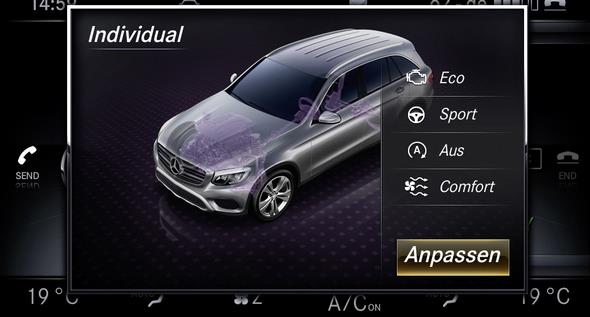
Streamlined transition
The design transition has also bestowed superlative aerodynamics on the new GLC, which sets a clear benchmark in this SUV class with a Cd value of 0.31 (GLK 0.34) and total aerodynamic drag of 0.794 (GLK 0.87).
Apart from the vehicle’s substantially more aerodynamically efficient basic shape, this exceptional aerodynamic performance also results from a host of solutions relating to points of detail:
- Cooling air controlled according to installed engine variant, with ring-type shutter
- Improved sealing of the radiator section and flow properties to make efficient use of the available cooling air
- Streamlined design of the front and rear aprons
- Sealed headlamp surrounds
- Three-dimensional front wheel spoilers with patented slotted wheel arch linings for optimised air flow around the wheels
- Aeroacoustic and aerodynamic design of the A-pillar
- Extended roof spoiler with optimised flow properties and joint seals
- Aerodynamically optimised underbody with extensive engine compartment and underbody panelling
Aerodynamically optimised wheels and tyres
Driving enjoyment on and off-road
Dynamism, agility and ride comfort à la carte
Featuring a totally new chassis and suspension, the new GLC clearly surpasses its predecessor’s performance.
Numerous design measures have led to a further improvement in suspension and ride comfort accompanied by excellent driving dynamics and agility.
Key measures here include the switch from a three-link to a four-link front suspension, larger wheels at front and rear and the larger tyre sizes of up to 50.8 cm (20 inches).
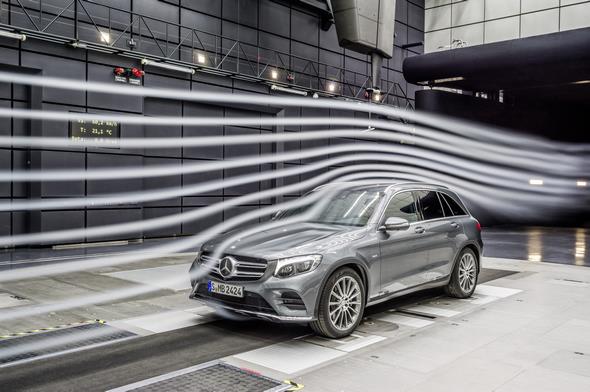
The elastokinematics have also been optimised, and the use of numerous aluminium components on the front axle and the five-link rear axle has resulted in weight savings while at the same time enhancing stability.
The GLC offers an AGILITY CONTROL suspension with steel springs and selective damping system as standard, optionally available with an emphasis on optional sporty performance, comfort or off-road performance:
- The base version features the comfort suspension, an accomplished synthesis of sporty directness and superior suspension comfort
- In combination with the AMG Exterior Line or as an individual option, a sports suspension firm-ride springs based on the AGILITY CONTROL suspension is available, with harder springing and a reduced roll tendency
- The GLC 350 e 4MATIC model and vehicles equipped with the Off-Road Engineering package feature a 20 millimetre higher driving level as standard for added ground clearance.
AIR BODY CONTROL with ADS Plus:innovative air travel
The GLC is the sole model in this market segment to offer the option of fitting the chassis with a full-support multi-chamber air suspension system and the electronically controlled, continuously adjustable Adaptive Damping System Plus (ADS Plus)
Thanks to alternating adaptation of the spring rate and damping characteristics, this configuration combines excellent driving stability and sporty agility with optimum comfort and outstanding off-road capabilities.
The air suspension struts at the front and rear axles have several chambers which are coordinated by solenoid valves depending on the driving situation.
A compressor also enables the pressure in the spring strut to be selectively raised or lowered.
This provides the required spread from soft basic damping with a long spring travel for comfortable cruising to a firm setup with shorter spring travel for highly agile lateral dynamics.
If one wanted to transfer this level of flexibility to a vehicle with a conventional steel suspension, it would mean that e.g. the length and material thickness of the coil springs would need to be constantly varied.
Fully automatically, within milliseconds and from many thousands of options, AIR BODY CONTROL therefore always selects the best possible suspension setup for the relevant conditions.
The same applies to the continuously variable Adaptive Damping System ADS Plus.
Here too, the control unit selects the best possible damping characteristics from endless possibilities.
ADS Plus and AIR BODY CONTROL are networked by an innovative, integrated control concept.
Thanks to this networking and extremely short response times of around 60 milliseconds, very high driving dynamics are achieved without compromising comfort.
During evasive manoeuvres in COMFORT mode, for example, the spring and damping forces are instantly increased to optimise roll control and therefore handling stability.
The system responds in the opposite way if a pothole is driven over when cornering in SPORT mode.
The air suspension and damping then respond more softly at the relevant wheel, depending on driving stability.
Further benefits of AIR BODY CONTROL include reduced roll during cornering, automatic level control and lowering of the load compartment sill by 40 mm for convenient loading and unloading.

A perfect match: DYNAMIC SELECT and AIR BODY CONTROL
Specific characteristic are pre-selected according to the settings of the DYNAMIC SELECT driving dynamics program.
In Sport+ mode the GLC’s occupants feel as if they are sitting in a sports car with a high level of lateral dynamics due to the tauter connection of the chassis, which is additionally lowered by 15 millimetres.
Comfort mode offers the very opposite ride experience, focussing on particularly comfortable running with soft connection of the chassis.
If the GLC is equipped with the Offroad Engineering package, AIR BODY CONTROL can raise the suspension level by up to 50 millimetres for a ground clearance of 227 millimetres – the top figure in this class.
If they are accompanied by a particularly soft basic setup, the wheels are able to maintain prolonged ground contact and considerably improve off-road performance.
The new GLC offers the DYNAMIC SELECT handling control system with five driving programs as standard:
- ECO – places the emphasis on energy-efficient driving, with sailing function and ECO display in support of the most fuel-efficient driving style
- COMFORT – well-balanced driving mode, with comfortable suspension tuning, fuel-efficient set-up for the drive system
- SPORT – more direct response of engine and automatic transmission and more progressive steering characteristics support a sporty driving style, additionally taut, sporty suspension configuration in conjunction with AIR BODY CONTROL and ADS Plus
- SPORT+ – even more direct response for maximum longitudinal and lateral dynamics, suspension level is lowered by 15 mm if AIR BODY CONTROL has been specified
- INDIVIDUAL – configuration according to personal preferences, within the bounds of combinations providing for safe and effective driving dynamics The COMFORT, SPORT and ECO settings for drive system, suspension and steering can be activated and combined according to personal preferences.
All DYNAMIC SELECT modes are individually visualised on the central media display.

The climbing ability of a dedicated off-roader thanks to the Offroad Engineering package
In addition to the standard-fit DYNAMIC SELECT dynamic handling control, the new all-rounder GLC can be combined with the Off-Road Engineering package and the AIR BODY CONTROL air suspension.
In all, five modes are then available: Slippery, Trailer, Off-road, Incline and Rocking Assist. The characteristics in detail:
- Offroad – light terrain such as tracks, rubble or sand, driving level is raised by 15 millimetres
- Incline – optimises the GLC’s climbing capabilities, driving level is raised by 15 mm
- Rocking Assist – the ideal remedy should the vehicle become stuck. Ground clearance is raised by 50 millimetres, the wheel-slip control thresholds are increased to enable the vehicle to work its way free,
active up to 20 km/h. - Slippery – ideal for low friction values, such as apply on muddy surfaces, wet grassland, on slippery snow or ice and when using snow chains
- Trailer – facilitates manoeuvring with a trailer in adverse conditions, for example on wet grassland or on a boat ramp
The Off-Road Engineering package additionally includes a robust Gemtex underride guard, which takes the stress out of heavy ground contact as on the previous model.
Downhill Speed Regulation (DSR) is also included for controlled downhill driving. The driver can pre-set a speed using the cruise control lever.
This set speed is then maintained automatically on downhill stretches, without any need to operate the brake pedal.
As with the other DYNAMIC SELECT modes, the off-road animations are also presented on the central media display.
Various parameters such as incline, tilt angle, steering angle, heading or the AIR BODY CONTROL settings, are displayed dynamically in real time.

4MATIC permanent all-wheel drive: the prime mover for excellent driving dynamics
The nine-stage 9G-TRONIC automatic transmission also comes as standard on the GLC 220 d 4MATIC, GLC 250 d 4MATIC and GLC 250 4MATIC.
Depending on the mode selected for the DYNAMIC SELECT dynamic handling control, the automatic transmission with a torque converter boasts great agility and responsiveness or poised composure.
The potential of the transmission is exploited to the full. It offers an impressively high shift speed and perfect transitions for energetic sprinting as well as gentle, barely perceptible gearchanges for enjoyable cruising.
The development engineers have fully revised the design of 4MATIC permanent all-wheel drive in combination with 9G-TRONIC.
In contrast to the former configuration, the single-stage transfer case is no longer integrated into the automatic transmission, but rather flange-mounted on the 9G-TRONIC as a separate system.
This “add-on” solution combines the advantages of both concepts and results in increased efficiency.
The new all-wheel-drive powertrain features the same compact design as with the previous, integrated solution, offers 50 newton metres of pre-lock torque and allocates the drive torque to the front and rear axles with a 45:55 split via a planetary differential. The add-on design also offers the following advantages:
- Enhanced performance – use of particularly torquey engines possible
- Separate oil circuits – lubricant properties tailored specifically to the 9G‑TRONIC and the transfer case, resulting in less wear and enhanced NVH comfort as a result of reduced friction loss
- Weight advantage – magnesium housing of the 9G-TRONIC is retained with the add-on solution, resulting in weight savings of around 12 kilograms for the overall system compared to the integrated variant with aluminium housing which was employed on the previous model.
- Improved system efficiency – as a result of the reduced weight, the lower friction loss, the broad gear ratio spread of the 9G-TRONIC and the resultant longer axle ratios
As with all hybrid models from Mercedes-Benz, the GLC 350 e 4MATIC is equipped with the latest version of 7G-TRONIC PLUS which has been specifically optimised in line with the needs of hybrid applications, and also combines high driving dynamics with excellent drive comfort and superior efficiency.
Active and passive safety
SUV stands for safety and responsibility
Virtually all of the driver assistance systems which are familiar from the
C-, E- and S-Class are available for the new GLC.
As part of the Intelligent Drive Concept, these systems combine data from various sensor technologies to enhance comfort and safety substantially.
COLLISION PREVENTION ASSIST PLUS, Crosswind Assist, Headlamp Assist and ATTENTION ASSIST are on board as standard.
Even more comprehensive active safety is made possible by the Driving Assistance package Plus including DISTRONIC PLUS with Steering Assist and Stop&Go Pilot, PRE‑SAFE® Brake with pedestrian detection, BAS PLUS with Cross-Traffic Assist, Active Blind Spot Assist, Active Lane Keeping Assist and PRE-SAFE® PLUS.
The basis for the numerous functions of the assistance systems is an extensive sensor system that provides the vehicle with a 360-degree view.
This includes a new stereo multi-purpose camera (SMPC) behind the front windscreen in the area of the rear-view mirror and hence at the level of the driver’s eyes.
Two camera eyes provide it with a three-dimensional view of the area up to around 50 metres in front of the vehicle, and it is able to monitor the overall situation ahead for a range of up to 500 metres and thus determine the position and movement of objects, especially of vehicles and pedestrians.
Two short-range radar sensors in the front bumper and at the side of the rear bumper respectively (range up to 30 metres), a long-range radar (up to 200 metres) including mid-range scan (up to 60 metres) behind the radiator grille and a multi-mode radar (up to 80 metres) in the centre of the rear bumper complete the sensor system.
The data from the camera and radar is compiled in a control unit in order to provide relevant data for a host of assistance systems – a process dubbed “sensor fusion” by safety experts.
Intelligent algorithms analyse this data in order to detect and pinpoint the position of vehicles ahead, crossing, approaching from the rear and even from the front, as well as of pedestrians, within a large field of vision.
In addition, the camera also detects road markings and a variety of traffic signs.
The aim is all-round protection not just for occupants of the vehicle itself, but for other road users too.
The new GLC is fitted as standard with ATTENTION ASSIST, which can warn the driver of inattentiveness and drowsiness.
The COMAND system navigation function on motorways flags nearby break options as stopovers, providing the system has been specified in the vehicle.
The ATTENTION ASSIST function offers an adjustable level of sensitivity and can inform drivers in a separate view in the instrument cluster about their level of drowsiness and how long they have been driving since their last break.
COLLISION PREVENTION ASSIST PLUS:
Autonomous braking when a rear-end collision threatens
Also part of the on-board standard equipment is COLLISION PREVENTION ASSIST PLUS with extended capabilities.
The further enhanced system can provide even more effective aid in mitigating the severity of rear-end collisions or even in preventing them entirely.
To this end, the radar-based system constantly monitors the area of traffic in front of the vehicle, and can determine the distance and speed of the vehicles ahead.
If the distance drops clearly below the safe threshold, the system issues a visual warning to the driver.
If it detects a serious risk of collision, the driver receives an additional audible warning. At the same time, the system computes the braking power required to still prevent the impact in the ideal case at speeds from as low as 7 km/h.
If the warned driver then depresses the brake pedal firmly, the system is capable of boosting insufficient braking commensurate to the situation.
In so doing it makes the best possible use of the remaining distance in order to leave vehicles following behind space for braking manoeuvres.
If the driver fails to react, new COLLISION PREVENTION ASSIST PLUS can go one step further and autonomously brake for slower or stopping vehicles.
The system even brakes when stationary vehicles are detected up to a speed of 50 km/h, and can prevent rear-end collisions up to 40 km/h depending on the situation.
More comfort thanks to linear and lateral guidance: DISTRONIC PLUS with Steering Assist
The proximity control system DISTRONIC PLUS helps the driver to keep the vehicle at a set distance from a vehicle ahead which is travelling at a slower speed.
This basic radar-based function has now been enhanced by the addition of Steering Assist, which helps the driver with lateral guidance.
The system helps the driver to keep the vehicle in the middle of its lane by generating a steering torque when driving in a straight line or even on slight bends.
The stereo camera recognises lane markings as well as vehicles driving ahead together with their spatial positioning, and relays this information to the electric steering assistance system.
When driving at slow speeds, e.g. in congested traffic, Steering Assist can use the vehicle ahead as a means of orientation, enabling semi-autonomous following of tailbacked traffic even when there are no clear lane markings visible.
The system can therefore increase ride comfort and considerably reduce driver stress in many traffic situations.
DISTRONIC PLUS with Steering Assist can be activated in a speed range between 0 and 200 km/h with a selector lever on the steering wheel.
The desired speed can be set between 30 km/h and 200 km/h.
Drivers must keep their hands on the steering wheel at all times even when Steering Assist is activated, as the function only works on bends with a radius above a certain, speed-dependent level.
Legal considerations also mean there are no plans to introduce hands-free driving. The system’s design is so refined that the sensors can detect whether the driver’s hands are on the steering wheel.
If they are not, the system first gives the driver a visual warning. If the driver fails to react, the system gives an audible warning and lateral guidance is deactivated.
Linear control remains unaffected by this and continues to be available. Needless to say, the driver is able to override Steering Assist at any time.
If the driver signals to change lane, for instance, the lateral guidance function will switch into passive mode for the duration of the lane change.
The performance capabilities of the basic DISTRONIC PLUS function have been increased once again.
Now the system is able to brake at a rate of up to 5 m/s² without any intervention from the driver.
There is faster acceleration if the “SPORT” modes are activated. Vehicle acceleration is also far more dynamic if the driver signals a wish to overtake by switching on the indicators, assuming the adjacent lane is clear.
By combining the radar and camera data, DISTRONIC PLUS is also able to detect both vehicles cutting in and vehicles ahead in adjacent lanes and take any necessary action promptly.
This can prevent illegal overtaking on the inside lane on motorways and similar multi-lane highways, for example, by adapting the speed to that of vehicles in the outside lanes.
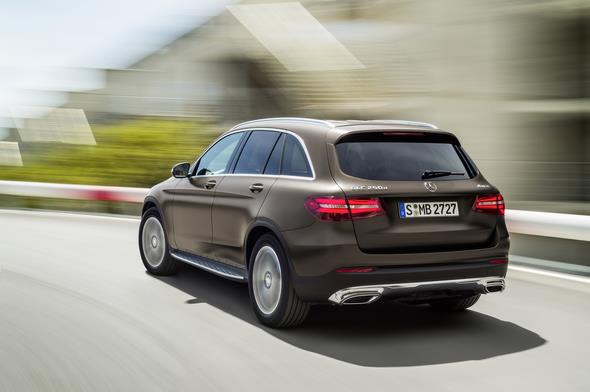
More safety on junctions: BAS PLUS with Cross-Traffic Assist
Apart from material damage, accidents at junctions often result in serious injuries.
The new Brake Assist BAS PLUS with Cross-Traffic Assist from Mercedes-Benz is therefore not only capable of helping the driver prevent or mitigate the severity of rear-end collision in linear traffic.
The Cross-Traffic Assist function can also help in the event of impending collisions with crossing traffic at junctions.
If this anticipatory system detects a hazardous situation of this type, it prompts the driver to start emergency braking by issuing visual and acoustic warnings.
If the driver presses the brake pedal too tentatively, BAS PLUS will step in by automatically boosting brake pressure for effective emergency braking, even applying the brakes at full power if necessary.
Applying just the right amount of braking power for the situation at hand maximises the available braking distance for traffic behind.
The Cross-Traffic Assist function is effective at speeds up to around 72 km/h, while BAS PLUS is able to aid the driver in linear traffic at any speed.
BAS PLUS with Cross-Traffic Assist is potentially able to either prevent or lessen the severity of around 27 percent of all accidents at road junctions resulting in injury.
This equates to some 20,000 accidents a year in Germany alone (source: investigations carried out by GIDAS – German In-Depth Accident Study – and Mercedes-Benz accident research).
For more safety in urban traffic: BAS PLUS and PRE-SAFE® Brake
Pedestrian recognition has been added to the BAS PLUS and PRE-SAFE® Brake functions. Autonomous braking for vehicles in front has also undergone a major enhancement.
Thanks to the combination of stereo camera and radar sensors, it is now possible to detect pedestrians in front of the vehicle.
Visual and acoustic warnings are triggered when a hazard is detected. If the driver reacts by braking, the braking power will be boosted by BAS PLUS with Cross-Traffic Assist as the situation requires, right up to full brake application.
If the driver fails to react, PRE-SAFE® Brake will brake the vehicle autonomously. PRE-SAFE® Brake with pedestrian detection is active up to approx. 72 km/h and can autonomously prevent collisions with pedestrians when travelling at up to 50 km/h.
Analyses of GIDAS accident data indicate that this new technology could prevent six percent of pedestrian accidents and reduce the severity of a further 41 percent.
The operating range of the autonomous braking function for stationary vehicles has been optimised so that rear-end collisions can likewise be prevented at speeds of up to 50 km/h.
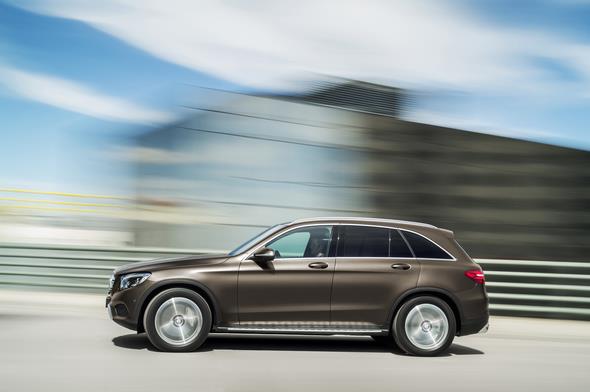
Preventive protection when a rear-end collision threatens: PRE-SAFE® PLUS
PRE-SAFE® PLUS is an extension of the familiar occupant protection measures when dangers are posed by following traffic.
A radar sensor in the rear bumper monitors the traffic following behind the car. If the risk of an impact from the rear is detected, the rear hazard warning lights are activated to alert the driver of the vehicle behind (not on vehicles with USA/Canada coding).
In addition, the PRE‑SAFE® preventive occupant protection measures, for example the reversible belt tensioners, are deployed.
If the vehicle is stationary and the driver wishes it to remain so (e.g. by applying the brakes, activating the HOLD function or engaging “P” using the selector lever), PRE-SAFE® PLUS comes to the driver’s aid by increasing the brake pressure.
The vehicle’s brakes are “locked”.
Keeping the vehicle firmly braked greatly reduces the strain placed on the occupants, such as the risk of whiplash injuries.
At the same time, it serves to protect other road users too. Uncontrolled vehicle movements after the initial impact that could lead to secondary collisions are reduced.
These could be running into a vehicle in front or colliding with pedestrians or other road users at junctions, for example.
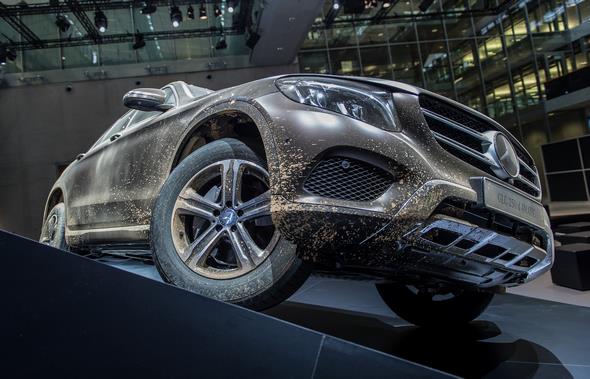
Responds to solid and broken lines on the road: Active Lane Keeping Assist
The new improved version of Active Lane Keeping Assist is now also able to intervene should the driver inadvertently cross a broken line when the neighbouring lane is not clear, meaning that a lane change could result in the risk of a collision.
The system can determine if this is the case using the information from the stereo camera and the radar system.
The latter has been supplemented by a sensor at the rear, which works in unison with the other sensors in the front and rear bumper.
Active Lane Keeping Assist is not only capable of recognising critical situations such as overtaking vehicles, vehicles to be overtaken and parallel traffic, it can also respond effectively to oncoming traffic.
When the adjacent lane is occupied, the system not only warns the driver with pulsing steering wheel vibrations when crossing the lane markings, but also intervenes with one-sided, course-correcting braking action induced by ESP®.
It thereby complements Active Blind Spot Assist, and for the first time also makes it possible to avoid collisions with oncoming traffic, which can often have far-reaching consequences.
Active Lane Keeping Assist is active at speeds between 60 and 200 km/h.
If driver activity in the form of active steering, braking or acceleration, for example, is detected or when the indicators are switched on, both the warning and the corrective brake actuation are suppressed.
Warning of no-overtaking and no-entry signs: Extended Traffic Sign Assist
A new Traffic Sign Assist which builds on the capabilities of the previous Speed Limit Assist represents yet another major contribution to accident prevention from Mercedes-Benz.
The system is now also able to recognise no-overtaking zones and alert drivers to no-entry restrictions.
The camera on the inside of the windscreen continues to pick up speed limit signs, including those on overhead gantries and in roadworks, for example.
The camera’s data is cross-referenced against the information in the navigation system and can be displayed both in the instrument cluster and on the map display.
If the camera fails to spot any road signs showing a speed limit or a speed limit is lifted, the legal speed limits based on the navigation data are shown instead, such as a maximum speed of 100 km/h on country roads in Germany or 50 km/h in built-up areas.
No-overtaking zones and the signs ending such zones are also registered and displayed.
In the case of signs imposing access restrictions, the system emits an acoustic warning together with a visual warning in the instrument cluster – making an effective contribution towards the prevention of serious accidents caused by wrong-way drivers.

Automatic parking manoeuvres: Active Parking Assist
Active Parking Assist enables automated parking with active steering and brake intervention in both parallel and perpendicular parking spaces.
It is an advanced version of the PARKTRONIC system with Parking Guidance offered previously.
What is more, the system is now also able to manoeuvre out of parallel parking spaces again all by itself with automatic steering and brake control, assuming the vehicle was parked there automatically beforehand.
When travelling at speeds below 30 km/h, ultrasound sensors with an extended range in the bumpers’ side sections survey the right side of the road for suitable parallel and end-on parking spaces.
The same procedure is carried out for the left side of the road if the driver activates the left turn indicator.
A symbol in the instrument cluster shows that the system is in the process of measuring.
If a suitable parking spot is identified, an arrow appears alongside the symbol indicating that the system is ready for automatic parking.
All the driver now has to do to activate the system is engage reverse gear and confirm by pressing the OK button on the steering wheel.
Active Parking Assist steers and brakes the vehicle automatically and shows the necessary action that the driver needs to take in each case in the display, such as engaging the correct gear.
The driver is able to control acceleration of the vehicle by lightly pressing the accelerator or releasing the brake.
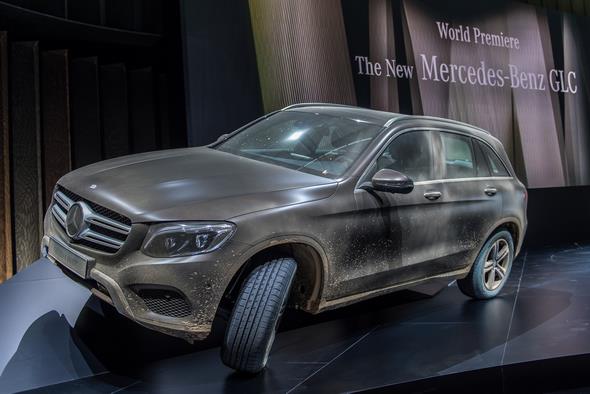
Continuous high beam without dazzle: Adaptive Highbeam Assist Plus
Some 20 percent of all kilometres driven in Germany are driven at night. But 40 percent of all accidents happen during that time.
One of the main reasons for this is reduced visibility.
For the first time, Adaptive Highbeam Assist Plus allows the high-beam headlamps to be kept on permanently while driving by masking out any other road user detected in the beams’ cone of light.
If the camera-based system registers either oncoming traffic or vehicles ahead, it will adapt the light distribution according to the traffic situation when high beam is switched on. Consequently, the driver can leave the high-beam headlamps on at all times and use their full range without irritating or even endangering other road users.
There is no need to switch them on and off manually, resulting in a significant increase in the overall driving time with high beam.
Adaptive Highbeam Assist Plus likewise makes use of the stereo camera also employed by other assistance systems.
If its image recognition algorithm picks up a vehicle that is oncoming or driving ahead, it actuates a mechanism in the headlamp module.
This then masks the section of the LED headlamps’ high-beam cone of light where there are other vehicles to prevent their drivers from being dazzled.
If road users are detected outside the area that can be masked – for instance when cornering with multiple vehicles in the headlamp beams – the system will switch to the familiar system of headlamp range control using the low-beam headlamps.
Possible backglare caused by increased use of the main beam and highly reflective signs at the side of the road is also detected and eliminated by dimming the headlamps accordingly.
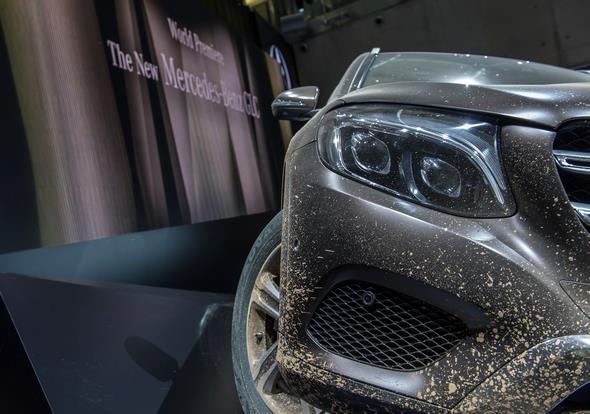
The key functions of the assistance systems on board the GLC
Comfort-oriented assistance
- DISTRONIC PLUS with Steering Assist – helps to keep the vehicle in its lane and is capable of following tailbacked traffic in semi-autonomous mode
Safety – linear guidance
- COLLISION PREVENTION ASSIST PLUS – can help to prevent rear-end collisions
- BAS PLUS – can also detect crossing traffic and pedestrians and boost the braking power applied by the driver, thereby reducing the severity of an accident
- PRE-SAFE® Brake – can detect pedestrians, avoid collisions with pedestrians or stationary vehicles by means of autonomous braking at vehicle speeds of up to 50 km/h and reduce the severity of collisions at speeds of up to 72 km/h
Safety – towards the rear
- PRE-SAFE® PLUS – can detect impending rear collisions, initiate PRE‑SAFE® occupant protection measures when a rear collision is imminent and lock the brakes of the stationary vehicle in a rear collision in order to reduce the loads acting on the occupants and to avoid secondary collisions
Safety – lateral guidance
- Active Kane Keeping Assist – can detect oncoming traffic and whether the adjacent lanes are occupied, and prevent the vehicle from leaving its lane unintentionally by applying the brakes on one side
Safety – at night
- Adaptive Highbeam Assist Plus – allows the main-beam headlamps to be kept on permanently without dazzling traffic by masking out other vehicles in the beams’ cone of light.
- Offroad light – specific off-road headlamp settings for broader illumination of the terrain ahead (in conjunction with Intelligent Light System and Offroad Engineering package) optimises orientation on off-road terrain
Safety during parking and manoeuvring
- Active Parking Assist – can manoeuvre into and out of parallel and end-on spaces with automatic steering
Driver attentiveness and fitness
- ATTENTION ASSIST – can warn of inattentiveness and drowsiness in an extended speed range from 60 to 200 km/h and inform the driver about their level of drowsiness and how long they have been driven since their last break
All-round visibility in the GLC
In addition to Active Parking Assist, simpler handling and a clearer view when manoeuvring in tight spaces or driving in dense urban traffic are ensured by the 360° camera, which is able to show the vehicle and its surroundings from different perspectives. Functions of the 360° camera in detail:
- The virtual bird’s-eye view shows an aerial view of the GLC and the surrounding area three metres to the front and rear and 2.5 metres to the sides of the vehicle.
- Display of perspectives which are not actually physically possible. For example, when manoeuvring in a multi-storey car park with a low ceiling a bird’s-eye view of the GLC and its surroundings are shown from a height of over three metres, although the ceiling is actually only a few centimetres above the vehicle.
- Visualisation of the sides of the vehicle and its surroundings to avoid knocks to the exterior mirrors or the wheel rims, for example.
- Visualisation of obstacles below the vehicle’s belt line, which are not visible to the driver.
- Visualisation of crossing traffic in front of and behind the vehicle when manoeuvring out of tight parking spaces or in tight exits.
- Visualisation of pedestrians on the pavement when manoeuvring out of tight parking spaces or in tight exits.
- Support when travelling off-road in demanding and confusing terrain.
- The colour of the GLC on the COMAND display always corresponds to the vehicle’s actual paintwork.
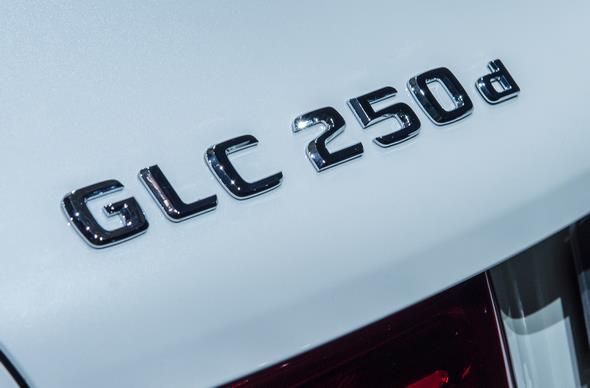
Relaxed driving experience
The improved ergonomics and simpler controls in the GLC compared to its predecessor also help to enhance safety.
All important vehicle functions and settings can be carried out intuitively using the central rotary pushbutton or the touchpad.
The desired settings or information are clearly visualised by the large, partially integrated colour media display in the middle of the dashboard.
Direct selection buttons next to the light switch module to the left of the steering wheel additionally enable direct activation of the most important assistance systems.
Also new is the Head-up Display (HUD). The HUD displays important information directly in the driver’s field of vision on the front windscreen, thus providing for clear legibility and less distraction from the road ahead.
The system provides information on speed, posted speed limits, navigation instructions and messages from the DISTRONIC system.
Hybrid body: the safe foundation
In keeping with the Mercedes-Benz tradition, the body forms the foundation for exemplary occupant protection in the event of a crash.
A high-strength safety passenger compartment forms the core of this concept. It is surrounded by specifically designed and crash-tested deformation zones, which ensure the best possible safety for the occupants by virtue of optimised force paths and a combination of die-cast aluminium components and ultra-high-strength materials.
This assures the new GLC of the potential to put in an excellent showing in all the worldwide rankings. The measures in detail:
- Highly robust passenger compartment consisting of high-strength and ultra-high-strength sheet steel, tailored blanks (sheet steel with graduated wall thicknesses) and cast aluminium components
- Bodyshell structure whose front and rear can absorb energy with purposeful deformations
- Large deformation zone of the front due to a subframe that absorbs additional energy in an accident
- Several parallel load paths for improved load distribution in partial frontal collision (offset crash)
- Additional strut made of high-strength steel between the damper dome and windscreen cross-member on the driver’s side which distributes the load from forces in the upper side member plane and reduces steering and pedal intrusion in the footwell.
- Additional firewall supports between the front and outer longitudinal members, which prevent the front wheel from intruding into the footwell in a severe offset frontal collision
- Extruded aluminium profile cockpit cross-member between the A-pillars
- Doors with reinforcement profile
- Main floor with massive tunnel reinforcement and now continuous floor side members
- Rear seat base with additional reinforcements, separated from the rear floor
- Composite rear structure with longitudinal floor members in graduated plate thicknesses and a corresponding rear centre section
On the GLC 350 e 4MATIC with plug-in hybrid technology, a lithium-ion battery and other high-voltage components are integrated in the rear area.
Special cast aluminium parts form a deformation-proof area to shield off these components.
Airbags & co.: cushioning protection for the occupants
Three-point seat belts with pyrotechnical belt tensioners and belt force limiters are installed for driver, front passenger and passengers on the outer rear seats.
The centre seat of the second row is equipped with a standard 3-point belt system. A rear seat-belt status display in the instrument cluster informs the driver whether the passengers in the back have fastened their seat belts.
ISOFIX child seat anchorage points on the outer rear seats ensure safe attachment of appropriate child seats with additional anchorage points at the top of the rear seat backrest.
The front passenger seat can be fitted with automatic child seat recognition, which dispenses with the existing transponder and instead works with a weight mat.
This enables any standard child seat to be used. The airbag is automatically deactivated in this case and reactivated once the child seat has been removed.
In addition, a host of airbags provides occupant protection in an accident.
These include:
- A newly developed windowbag in the area of the roof between the A, B and C-pillar for the head area of driver, front passenger and passengers in the outer rear seats.
- Combined thorax/pelvis sidebags for driver and front passenger, which are able to provide additional protection in the event of a side impact. Optional sidebags for the outer rear seats.
- Kneebag for the driver to protect the knees and stabilise the upper body, which positively influences occupant movement in an accident.
- Adaptive airbags for driver and front passenger with two-stage staggered deployment, depending on the detected severity of the impact and seat position.
The new GLC is equipped with Mercedes-Benz emergency call eCall. The emergency call can be made automatically or manually.
It is triggered automatically after deployment of one of the pyrotechnic belt tensioners or airbags in the vehicle.
The service centre then establishes voice communication with the vehicle.
Best possible protection for more vulnerable road users
Mercedes-Benz attaches priority to the protection of more vulnerable road users, such as pedestrians or cyclists.
An active bonnet is used which is lifted by 80 millimetres in certain accident constellations, creating additional deformation space.
Under the bonnet the package has been further optimised with a new engine cover and deformable air intake, creating yet more deformation space.
These measures ensure that the GLC meets the markedly more stringent Phase 3 requirements of Euro NCAP pedestrian protection.
BAS PLUS warns when pedestrians are detected in the danger zone by the stereo multi-purpose camera.
The PRE-SAFE® Brake with pedestrian protection triggers autonomous braking when the system detects a pedestrian in the danger zone and the driver does not react to the system’s warnings.
This pedestrian detection, in conjunction with the optionally available Driver Assistance package Plus, represents a milestone in preventing accidents with pedestrians and/or reducing their consequences.

